EDITOR’S NOTE: Please be advised that this Madrid travel guide hasn’t been updated in 2025. Prices and travel guidelines may no longer be accurate so it’s important that you verify any information before proceeding.
Madrid is one of our favorite cities in Spain. We enjoyed it more than Barcelona.
Barcelona attracts more international visitors than Madrid but the Spanish capital endeared itself to us with its cosmopolitan feel and more authentic vibe. In Barcelona, we felt like tourists but in Madrid, we felt almost like locals, so much so that we could really see ourselves living there.
If you enjoy walking, then you’re going to love Madrid. It’s a huge city but very walkable and with many interesting neighborhoods to explore. Its museums are second to none and like anywhere in Spain, the food is beyond incredible.
There’s so much to experience in the Spanish capital that I’ve put together this detailed Madrid travel guide to help you plan your trip. It’ll tell you everything you need to know to eat well, see as much as you can, and make the most of your time in Madrid.
VISIT MADRID QUICK LINKS
This Madrid travel guide is long. For your convenience, I’ve compiled links to hotels, tours, and other services here.
HOTELS
Top-rated hotels in Malasaña, one of the best and coolest areas to stay for first-time visitors to Madrid.
- Luxury: INNSIDE by Meliá Madrid Gran Vía
- Midrange: Hostal Adis
- Budget: Woohoo Hostal Madrid
TOURS
- Sightseeing Tour: Royal Palace Skip-the-Line Guided Tour
- Food Tour: Secret Food Tours Madrid
- Flamenco Shows: Flamenco in Madrid
OTHER SERVICES
- Visa Services
- Travel Insurance with COVID cover (WFFF readers get 5% off)
- Airport Transfers
- Car Rental
- Spain eSIM
- Go City Pass (tourist discount card)
Save This on Pinterest!
No time to read this Madrid travel guide now? Click on the save button and pin it for later!
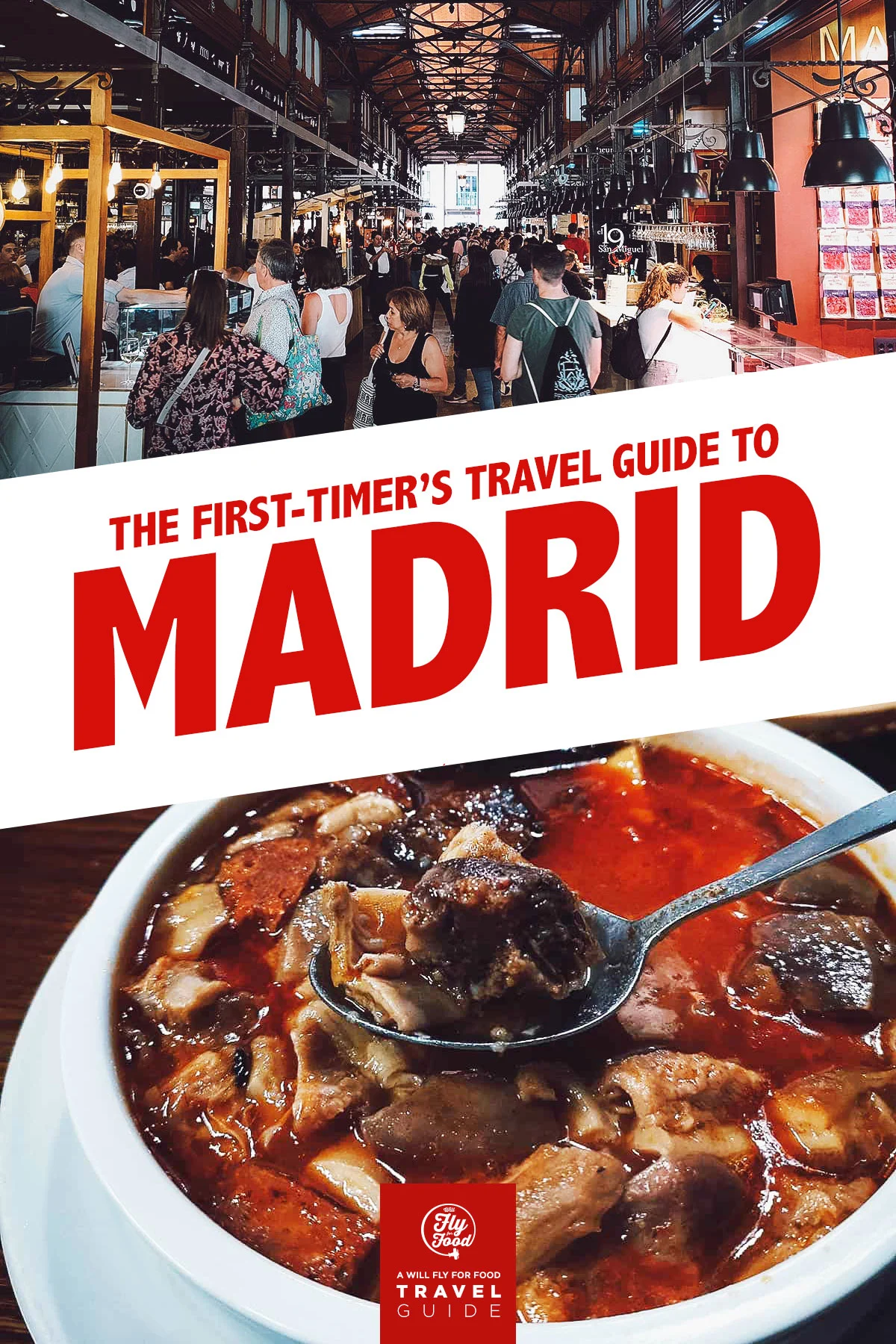
TRAVEL GUIDE TABLE OF CONTENTS
MADRID TRAVEL RESTRICTIONS
Because of the current global situation, Madrid travel guidelines change frequently. Our friends at Booking.com created a website that lists detailed information on travel restrictions around the globe.
Before reading this Madrid travel guide and planning your trip, be sure to check Booking.com for information on travel restrictions to Spain. If you do decide to visit Madrid, then you may want to seriously consider getting travel insurance.
SPAIN VISA
You may need a visa and other travel documents to visit Spain depending on what type of passport you carry. Check out iVisa.com to learn about the requirements and to apply for a visa (if necessary).
MADRID AT A GLANCE
Madrid is the Spanish capital and the country’s largest city by population. It’s a highly cosmopolitan destination that’s home to mouthwatering food, luxury shopping, and some of the world’s finest museums.
People looking for culture will have much to look forward to in Madrid. Aside from its many galleries and exhibit spaces, Madrid is home to three of the world’s most important museums – the Museo del Prado, Thyssen-Bornemisza, and Reina Sofía. Major works from some of Spain’s most celebrated artists like Pablo Picasso, Salvador Dalí, Diego Velázquez, and Joan Miró are on display there.
Fashionistas will enjoy strolling the Golden Mile and Gran Vía while Traveleaters with a taste for tapas and all things Spanish food will have their plates full in Madrid. Mercados abound and its vibrant restaurant scene covers the gamut from unpretentious tapas bars to Michelin-starred fine dining establishments.
BEST TIME TO VISIT MADRID
In terms of the weather, Mar-May and Sept-Nov are the best months to visit Madrid. They’re the mildest times of the year.
On our last trip, we visited Madrid in late April and the weather was perfect. It would be overcast on some days but it never rained. It wasn’t warm yet but we were fine getting around in just light jackets.
MAR-MAY: These are among the best months to visit Madrid. The weather in spring is ideal, especially towards late April and May. If you don’t mind slightly cooler temperatures, then March would be a good month to visit as well.
JUN-AUG: Summers in Spain can be unbearably hot. Getting around on foot or by metro can be uncomfortable so this may not be the best time to visit Madrid. On top of that, many business owners close shop in the summer to take month-long holidays themselves.
SEP-NOV: Like spring, autumn is one of the best times to visit Madrid. The weather is perfect.
DEC-FEB: If you don’t mind colder weather, then winter may not be a bad time to visit Madrid, especially with hotel prices being at their lowest all year. January is the coldest month with temperatures often dipping into the low 30s°F (around 0°C).
Climate: Annual Monthly Weather in Madrid
For more on Madrid’s weather, check out these climate graphs from holiday-weather.com. I’ve also created the average temperature and annual rainfall graphs below with the most ideal months to visit marked in orange.
Average Temperature
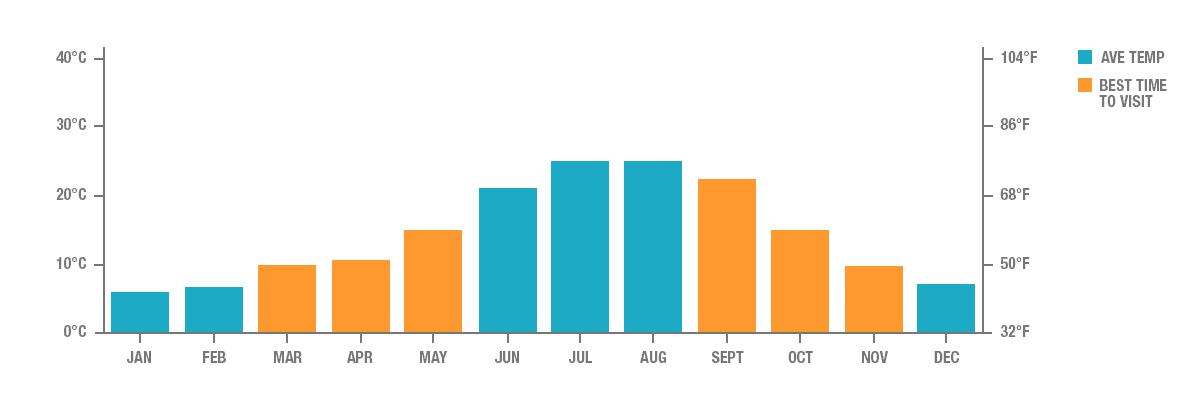
Annual Rainfall
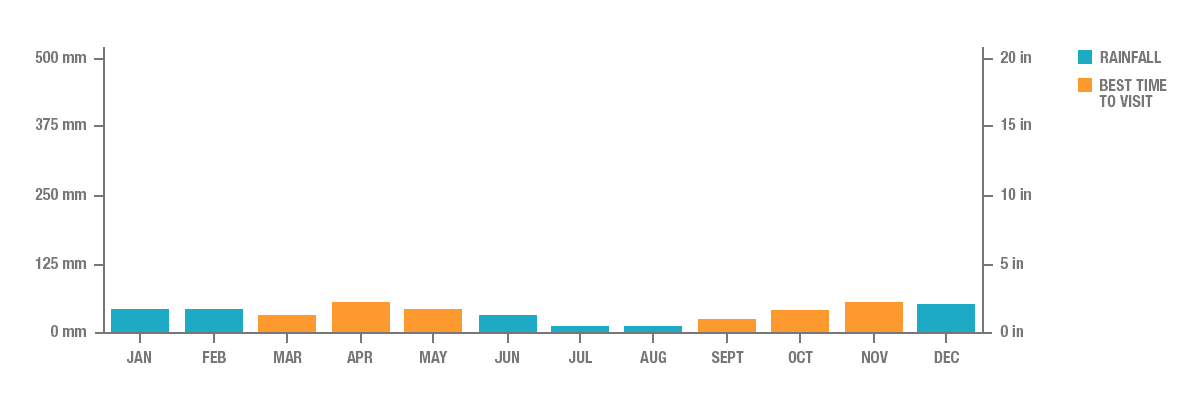
TRAVELING TO MADRID
We took a bus to Madrid from Granada in southern Spain but there are several ways to get there depending on where you are. I suggest checking Bookaway to find route options available to you. You can click on the link or use the widget below.
By Plane
People flying into Madrid will be arriving at Madrid Airport, officially known as Adolfo Suárez Madrid-Barajas Airport (MAD). It’s located about 9 km (5.6 mi) northeast of central Madrid. There are several ways you can get to your hotel in the city center from the airport.
Madrid Metro
Traveling by metro is one of the cheapest and fastest ways to get to central Madrid from the airport. Travel times and fares will vary depending on your final destination, but metro line 8 will get you into Nuevos Ministerios metro station in the city center in around 12-15 minutes. The metro operates from 6:05AM till 1:30AM.
Renfe Train
Lines C1 and C10 on the Renfe train will take you from Airport Terminal 4 to Nuevos Ministerios station in about 18 minutes. Trains run every 20-30 minutes.
Madrid Airport Express Bus
There are several buses you can take from the airport to downtown Madrid, the fastest being the Madrid Airport Express Bus. Line 203 will take you to the Atocha-RENFE hub in the city center in about 40 minutes. If you’re traveling at night, then it’ll drop you off at Plaza de Cibeles which is about 1.5 km (0.9 mi) north of the Atocha-RENFE station.
The Madrid Airport Express Bus operates 24/7 and runs every 15-20 minutes during the day and every 35 minutes between 11:30PM and 6AM. You can check the Madrid Airport website for more information and for other bus transfer options.
Taxi
Taking a taxi is more comfortable but also more expensive. The taxi ride from the airport to the M30 central area in Madrid is subject to a fixed fare of EUR 30. Just be sure to catch it from the official taxi stand at the airport.
Ridesharing
According to this TripAdvisor thread, regular commuters don’t really use ridesharing services like Uber in Spain, but it may be a good (and cheaper) alternative if the airport taxi queue is long. While Uber does operate in Madrid, most people prefer to use the FreeNow (MyTaxi) app. Another option is Cabify.
Private Transfer
If you’d like to have a private transfer waiting for you at the airport in Madrid, then you can book one in advance through Get Your Guide.
By Train
Spain has an extensive rail network, at the very heart of which is Madrid. If you’re in a city relatively near Madrid, then train travel may be better than flying as it’ll get you into a station already within the city center. From there, you can take the local metro or taxi to your hotel. You can check Trainline for route information and to book train tickets to Madrid.
By Bus
This was how we arrived in Madrid on our last visit. We took a 4.5 hr Alsa bus from Granada to Madrid Estacion Sur. If you’re traveling on a budget, then buses are a great way to get around in Spain as they’re cheaper than trains and just as comfortable. You can search for bus tickets to Madrid on Bookaway.
By Car
Renting a car is arguably the best way to explore Spain and Europe. We drove from San Sebastian to Santiago de Compostela and it turned out to be one of the most memorable legs of our trip. If you’d like to rent a car and drive to Madrid, then you can do so on Rentalcars.com.
WHERE TO EXCHANGE CURRENCY
The unit of currency in Spain is the Euro (EUR).
We withdrew EUR from ATMs throughout our entire stay in Spain so we didn’t have to change any currency in Madrid. This seems to be the de facto option in Spain and in many other European countries these days.
If you plan on using your ATM card in Europe, then I suggest letting your bank know before your trip. That way they don’t flag any transactions as suspicious. In my experience, my ATM card works fine in some machines but not in others. I had no problems withdrawing from ATMs anywhere in Spain.
NOTE: Many ATMs in Europe will ask if you’d like to proceed “with or without conversion”. Always proceed WITHOUT conversion so your hometown bank performs the conversion for you. Proceeding with conversion authorizes the foreign bank operating the ATM to do the conversion, usually at highly unfavorable exchange rates.
BEST AREAS TO STAY IN MADRID
If it’s your first time in Madrid, then it’s best to stay in Centro. Being in this central district will put you right in the heart of Madrid and close to many restaurants, cafes, bars, transportation options, and tourist attractions.
Centro refers to a large central area in Madrid composed of smaller neighborhoods, each with its own character. The first five areas recommended in this Madrid travel guide are part of Centro while the sixth is located directly east of this central district.
I’ve created a color-coded map to help you understand where these areas in Madrid are. Click on the link for a live version of the map. (Please note that marked areas are approximations only)
GREEN – Lavapiés
RED – Chueca
YELLOW – Malasaña
PURPLE – La Latina
ORANGE – Barrio de las Letras / Huertas
BLUE – Salamanca
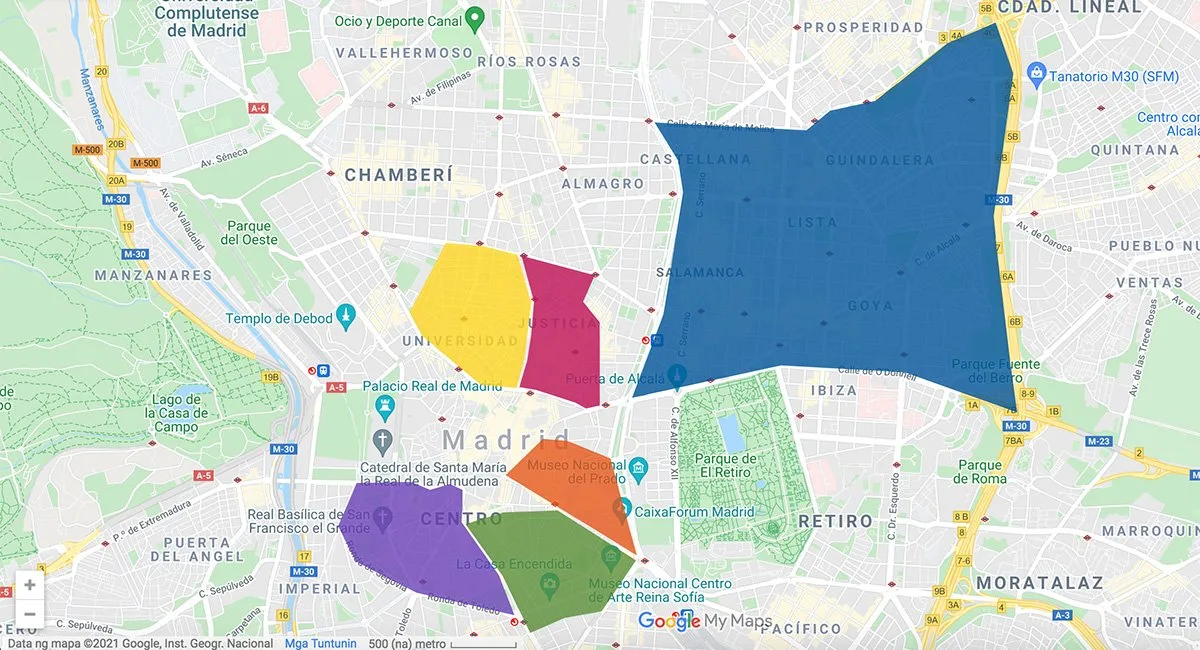
LAVAPIÉS
If you’re looking for a good budget hotel in Madrid, then the Lavapiés area is one of the best places for you to stay. It’s an artsy and culturally diverse neighborhood with lots of interesting Spanish and international restaurants, bars, and cafes, especially along Calle Argumosa.
Lavapiés offers plenty in the way of accommodations but do stick to the main streets and squares as some of the smaller side streets can get a bit seedy at night. You can book accommodations in Lavapiés on Booking.com. Check out some of the top-rated hotels in the area:
- Luxury: Atocha Hotel Madrid, Tapestry Collection by Hilton
- Midrange: Uma House Atocha
- Budget: 2060 The Newton Hostel
CHUECA
If an active nightlife scene is what you’re after, then Chueca is one of the best areas to stay in Madrid. It’s the hub of the LGBTQ community in Madrid and home to lots of trendy nightclubs, bars, restaurants, and cafes. It’s also a great destination for shopping as it’s home to many interesting boutiques and upscale shops, especially along Calle de Hortaleza.
You can search for accommodations in Chueca on Booking.com. Check out some of the top-rated hotels in the area:
- Luxury: Only YOU Boutique Hotel Madrid
- Midrange: Woohoo Rooms Chueca
- Budget: Bastardo Hostel
MALASAÑA
For younger travelers, Malasaña is arguably the best area to stay in Madrid. It’s one of the hippest areas in Madrid with a great mix of restaurants, tapas bars, pubs, boutiques, street art, and museums. It’s within walking distance to Calle Gran Vía as well which is home to some of the best shopping in Madrid.
You can book a hotel room in Malasaña on Booking.com. Check out some of the top-rated hotels in the area:
- Luxury: INNSIDE by Meliá Madrid Gran Vía
- Midrange: Hostal Adis
- Budget: Woohoo Hostal Madrid
LA LATINA
La Latina refers to the area just south of the Royal Palace and Almudena Cathedral. It’s within walking distance to Plaza Mayor and home to El Rastro flea market, the biggest in Madrid. It’s a very walkable area with elegant architecture and excellent tapas bars, many of which are clustered along Calle de Cava Baja.
You can search for accommodations in La Latina on Booking.com or Agoda. Check out some of the top-rated hotels in the area:
- Luxury: Posada del León de Oro Boutique Hotel
- Midrange: Posada del Dragón Boutique Hotel
- Budget: Hostel MYD La Latina
BARRIO DE LAS LETRAS / HUERTAS
Barrio de las Letras (or Huertas) is the literary quarter of Madrid and the best area to stay if the main purpose of your trip is to visit the city’s museums. It’s home to Paseo del Prado and the Golden Triangle of Art. Staying in this area will put you within walking distance of the Museo del Prado, Thyssen-Bornemisza, and Reina Sofía museums.
Huertas is located immediately to the west of Parque del Buen Retiro (Buen Retiro Park), one of the largest green spaces in Madrid. Together with Paseo del Prado, this expansive public park is considered a UNESCO World Heritage Site.
You can book a hotel room in Huertas on Booking.com. Check out some of the top-rated hotels in the area:
- Luxury: The Westin Palace, Madrid
- Midrange: Room Mate Alba
- Budget: Hostal Pacios
SALAMANCA
If you want a truly luxurious stay in Madrid, then look no further than Salamanca. It’s one of Madrid’s most exclusive neighborhoods and home to some of its swankiest hotels and restaurants. However, it isn’t as centrally located as the previous areas so you’ll need to take the metro to get to Madrid’s top tourist attractions.
You can find accommodations in this posh Madrid neighborhood on Booking.com or Agoda. Listed below are some of the top-rated hotels in Salamanca:
- Luxury: Relais & Châteaux Heritage Hotel
- Midrange: VP El Madroño
- Budget: Hostal Retiro
You can also book hotels and home stays in Madrid using the handy map below.
PLACES TO VISIT IN MADRID
1. Museo del Prado (Prado Museum)
The Prado Museum is one the most famous museums in the world. It’s the crown jewel of the Paseo del Arte (Art Walk), a one-kilometer stretch of major museums in Madrid’s city center. It’s home to a mind-blowing collection of European art, mostly from the Spanish, Italian, and Flemish schools of painting.
The Prado Museum features over 8,600 paintings and 700 sculptures from Spanish masters like Diego Velázquez, Francisco Goya, and Joaquín Sorolla. These are the types of priceless pieces that you read about in art textbooks and only dream about seeing in person.
You can purchase a ticket to Prado Museum in advance or book a guided tour but if you plan on visiting all three major museums in Madrid, then I highly recommend getting a Paseo del Arte pass.
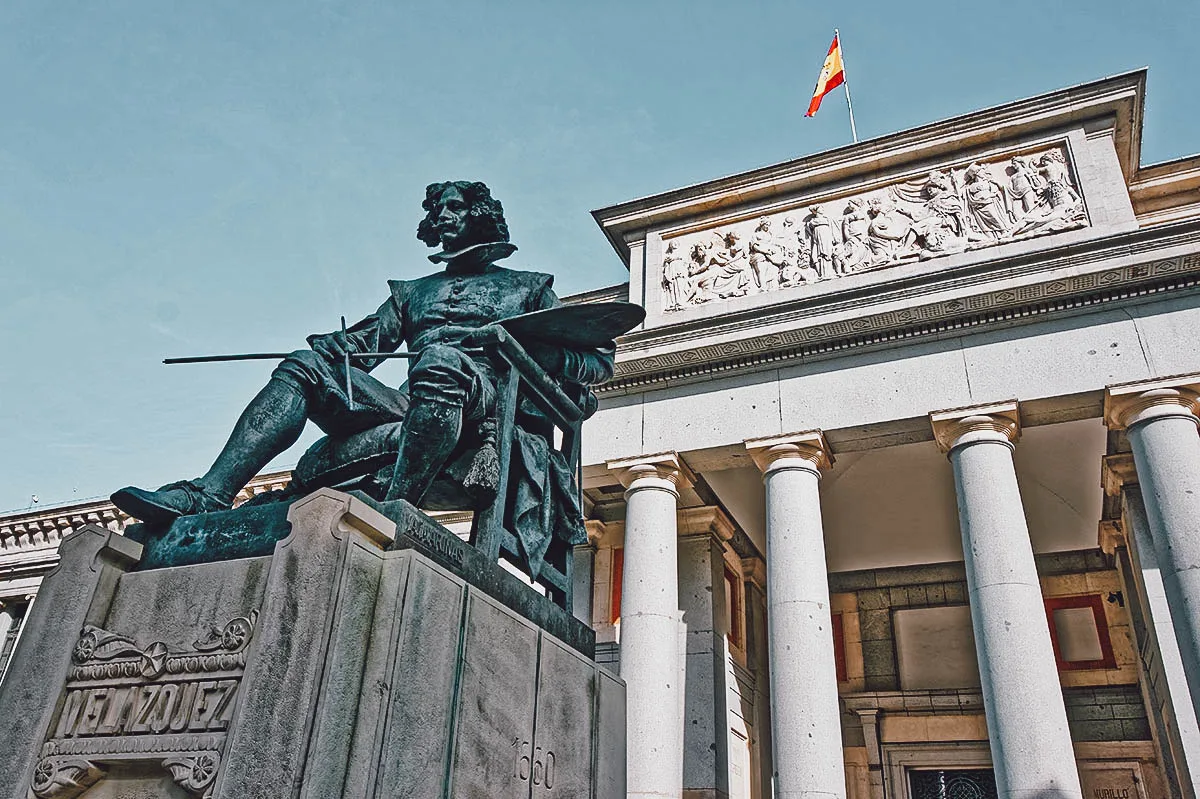
Photo by Enrique Palacio Sans via Shutterstock
Suggested Length of Visit: About 3-4 hrs
Admission: EUR 15
Operating Hours: 10AM-8PM, Mon-Sat / 10AM-7PM, Sun and public holidays
Nearest Metro Stations: Banco de España (L2), Estación del Arte (formerly Atocha) (L1)
2. Thyssen-Bornemisza Museum
Thyssen-Bornemisza is the second of the three major museums in Madrid. While the Museo del Prado is filled with priceless pieces from the Renaissance, this museum features a more modern collection from famous international and Spanish artists like Francis Bacon, Pablo Picasso, Marc Chagall, and Roy Lichtenstein.
If you prefer contemporary art, then you may enjoy the Thyssen-Bornemisza Museum more than the Prado. It’s a lot less crowded than the Prado Museum and they let you take pictures of the artworks.
You can visit Thyssen-Bornemisza on your own or book a guided tour. As advised, you may want to get a Paseo del Arte pass if you plan on visiting all three major museums on your own.
Suggested Length of Visit: About 2-3 hrs
Admission: EUR 13
Operating Hours: 12NN-4PM, Mon / 10AM-7PM, Tue-Sun
Nearest Metro Station: Banco de España (L2)
3. Museo Nacional Centro de Arte Reina Sofía
The Reina Sofia Museum is the third major museum in Madrid and personally, my favorite of them all. It’s a large modern museum housing over 22,400 works of contemporary Spanish and European art, many by renowned Spanish masters like Salvador Dalí, Joan Miró, Juan Gris, and Pablo Picasso.
You aren’t allowed to take pictures of it but one of Picasso’s most celebrated works, Guernica, is on display here. If you’re a fan of Picasso or Dalí, then you need to visit this museum.
You can purchase a ticket to Reina Sofía or book a guided tour but as advised, you’ll save money on the cost of admission if you get a Paseo del Arte pass.
Suggested Length of Visit: About 3-4 hrs
Admission: EUR 12
Operating Hours: 10AM-8PM, Mon, Wed-Sat / 10AM-2:30PM, Sun (closed Tue)
Nearest Metro Stations: Estación del Arte (formerly Atocha) (L1), Lavapiés (L3)
4. CaixaForum Madrid
If the big three aren’t enough to satisfy your craving for art and culture in Madrid, then you may want to visit CaixaForum. Located in Paseo del Prado, near the three major museums, CaixaForum Madrid is a sociocultural center with over 2,000 square meters (21,528 sq ft) of exhibit halls. The venue hosts multimedia displays, art exhibits, workshops, and music and poetry festivals.
You can check the CaixaForum website for a schedule of upcoming events in Madrid.
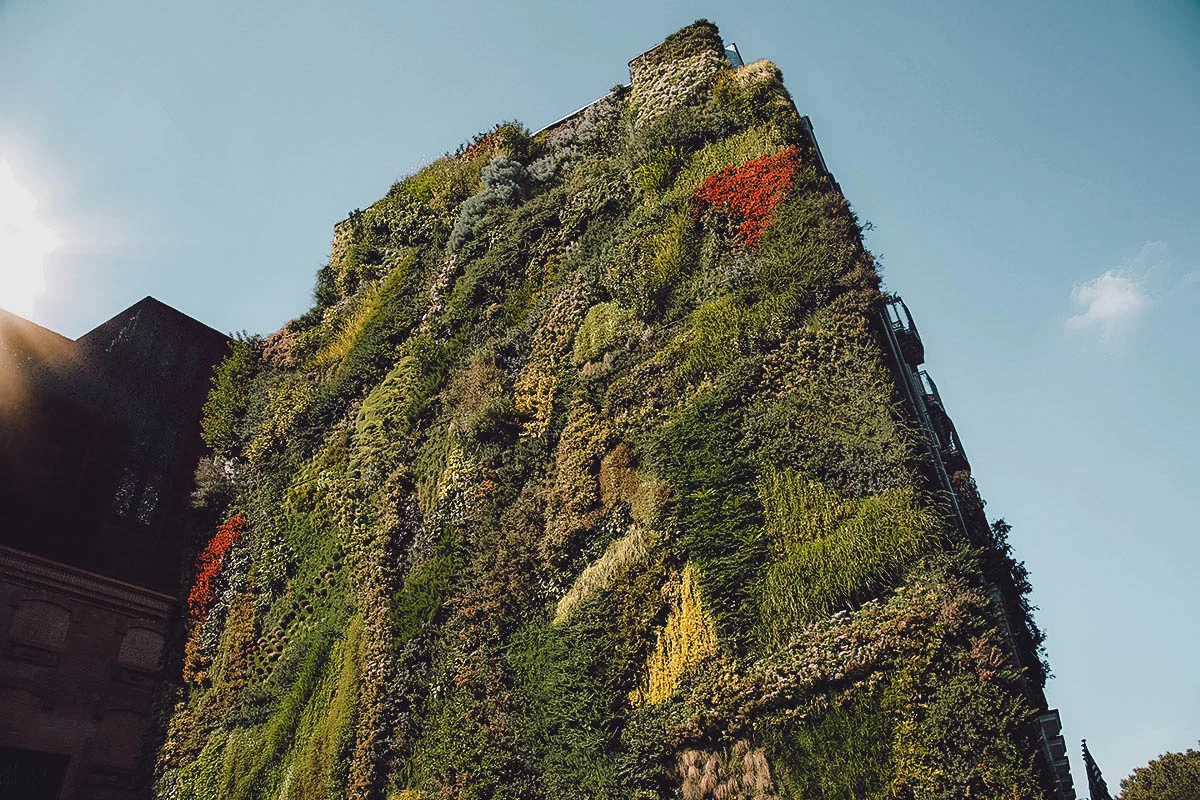
Photo by eskystudio via Shutterstock
Suggested Length of Visit: About 1-2 hrs
Admission: EUR 6
Operating Hours: 10AM-8PM, Sun-Thurs / 10AM-10PM, Fri-Sat
Nearest Metro Station: Estación del Arte (formerly Atocha) (L1)
5. Royal Palace of Madrid
The Royal Palace of Madrid once served as the family home to the kings of Spain, specifically from Charles III to Alfonso XIII. Today, it still functions as the royal family’s official residence though it’s used only for state ceremonies and has been opened to the public for viewing.
The Royal Palace contains over 3,400 rooms and is known to be the largest functioning royal palace in Europe. In fact, it’s so big that only a small section of the palace is shown to the public at any given time. The Royal Armoury and Kitchen are highlights as is the changing of the guard which takes place on Wednesday and Sunday every week.
You can purchase tickets at the gate, but if you’d rather not fall in line, then you may want to get fast-access tickets in advance or book a guided tour through Get Your Guide.
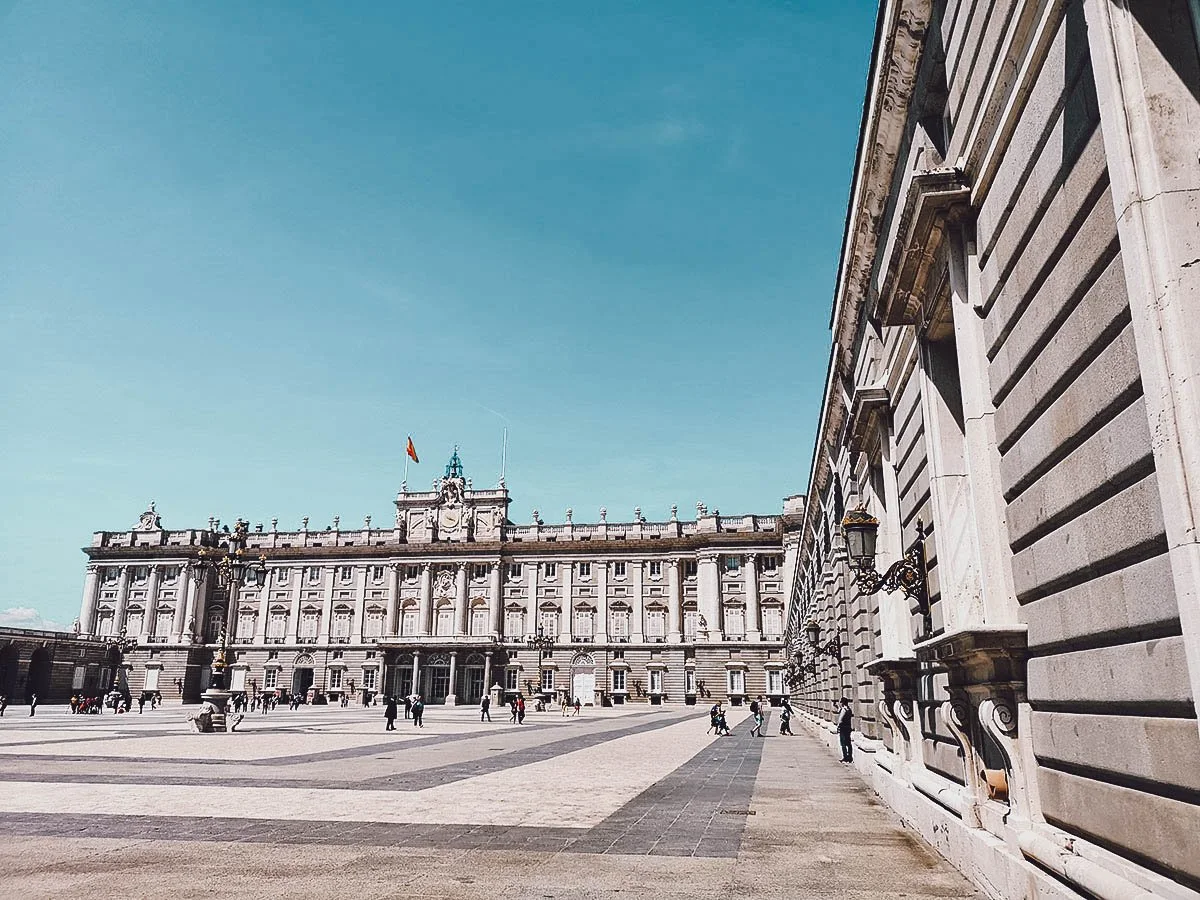
Suggested Length of Visit: About 2-3 hrs
Admission: EUR 12
Operating Hours: 10AM-6PM, Tue-Sat / 10AM-4PM, Sun-Mon
Nearest Metro Stations: Ópera (L2, L5, R), Plaza de España (L2, L3, L10)
6. Cibeles Palace
Located at Plaza de Cibeles, Cibeles Palace (or Palacio de Comunicaciones) is the former post office and telegraph/telephone headquarters of Madrid. Opened in 1909, this striking white building is known for its elegant architecture and offers some of the best panoramic views of the city.
Since 2007, Cibeles Palace has functioned as the seat of the Madrid City Council. It features a contemporary art gallery called CentroCentro and offers visitors 360° panoramic views of Madrid from its highest tower.
If you enjoy lofty views, then you may want to make a quick stop here. You can visit on your own or book a guided tour that makes a stop at Cibeles Palace.
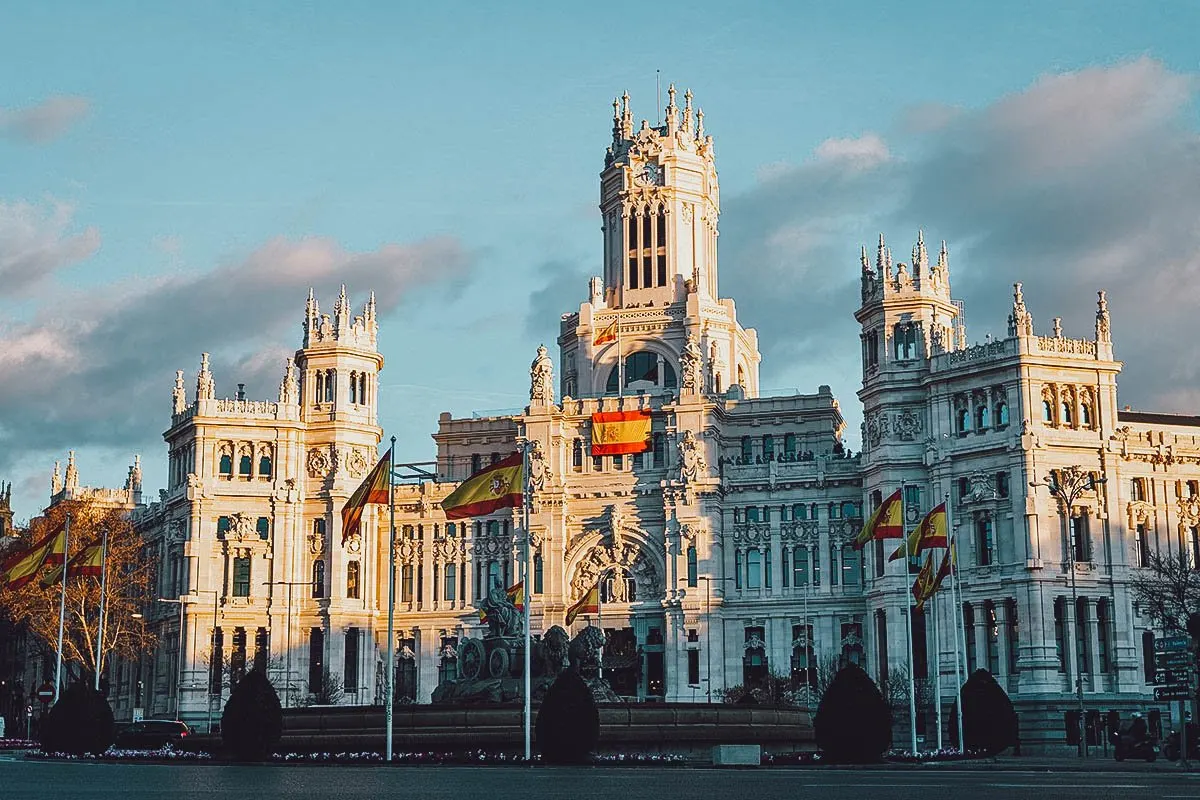
Photo by noelia leonor via Shutterstock
Suggested Length of Visit: About 1 hr
Admission: EUR 3
Operating Hours: 10AM-8PM, Tue-Sun (closed Mon)
Nearest Metro Station: Banco de España (L2)
7. Chamberí Ghost Station
If conventional museums aren’t your thing, then you may want to visit Chamberí Ghost Station instead. It refers to the now-disused Estación de Chamberí, one of the eight original stations on the Madrid Metro’s first line.
Opened in 1919, the station was permanently closed in 1966 before reopening as a museum called Anden or Platform 0 in 2008. It features the station’s original ads comprised of brilliantly-colored tiles, and offers a glimpse into the history and origins of Madrid’s metro system.
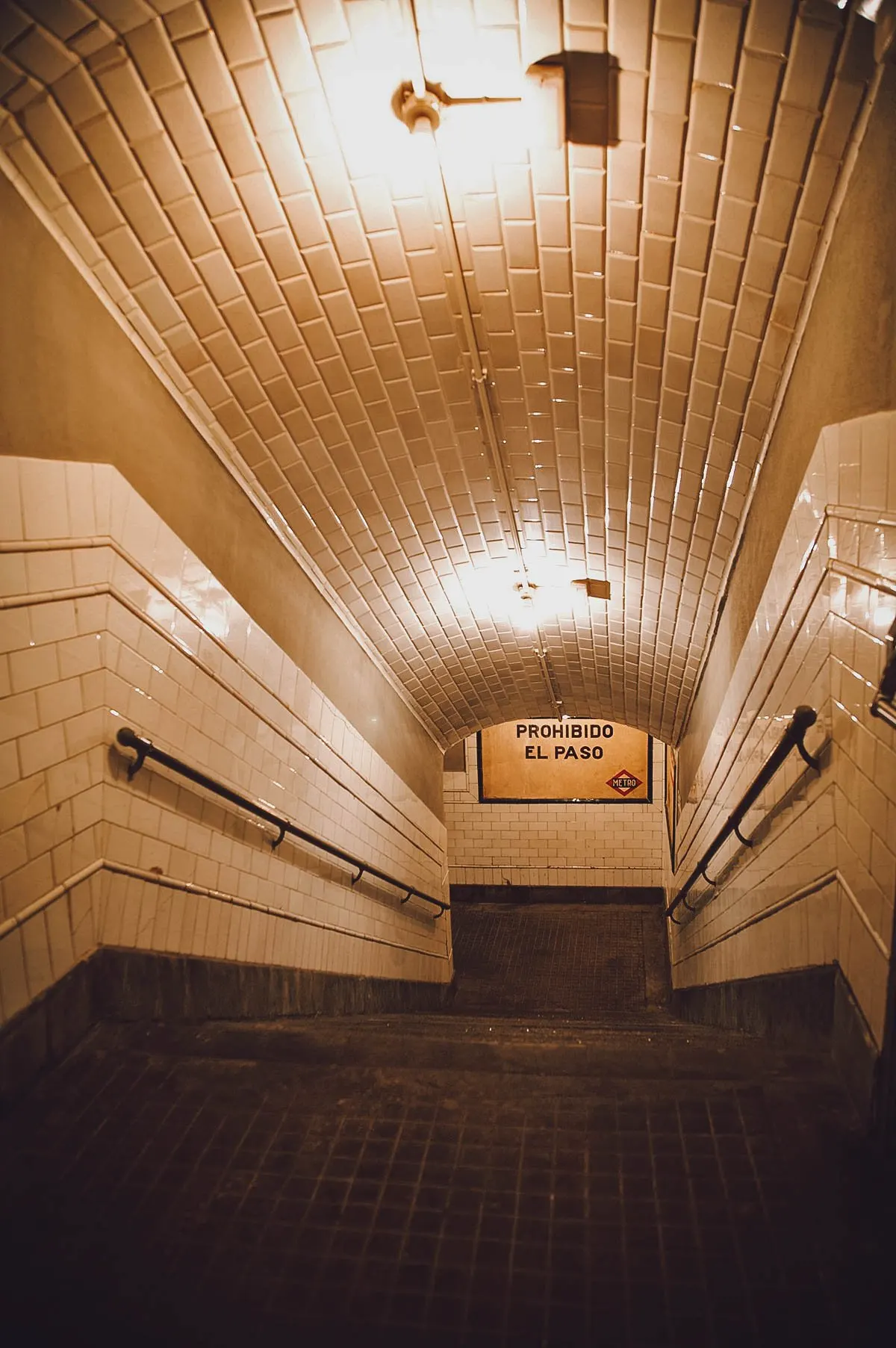
Photo by Quintanilla via Shutterstock
Suggested Length of Visit: About 30 mins – 1 hr
Admission: FREE
Operating Hours: 8:30AM-11PM, daily
Nearest Metro Stations: Alonso Martínez (L4, L5, L10), Bilbao (L1, L4), Iglesia (L1), Quevedo (L2), Rubén Darío (L5)
THINGS TO DO IN MADRID
1. Enjoy Bocadillo de Calamares at Plaza Mayor
Plaza Mayor is one of the most emblematic landmarks in Madrid. Located in an area called Madrid de los Austrias (Hapbsurg Madrid), this public square with 400 years of history is the heart and soul of Old Madrid.
Plaza Mayor is one of the most popular places in the city for tourists to eat, people watch, and enjoy the outdoors. Aside from the famous Mercado de San Miguel, you’ll find a lot of small restaurants and tapas bars around Plaza Mayor. Many serve bocadillo de calamares, a classic Madrid snack consisting of battered squid rings served in a bun. Order one and eat it outside like a local.
There are many ways to get to Plaza Mayor but I suggest walking up Calle de Cuchilleros and entering the square through Arco de Cuchilleros. It’s a monumental and impressive-looking archway with steep steps that lead you up and into the square.
You can easily visit Plaza Mayor on your own but if you’d like to go on a guided tour, then you can book one through Get Your Guide.
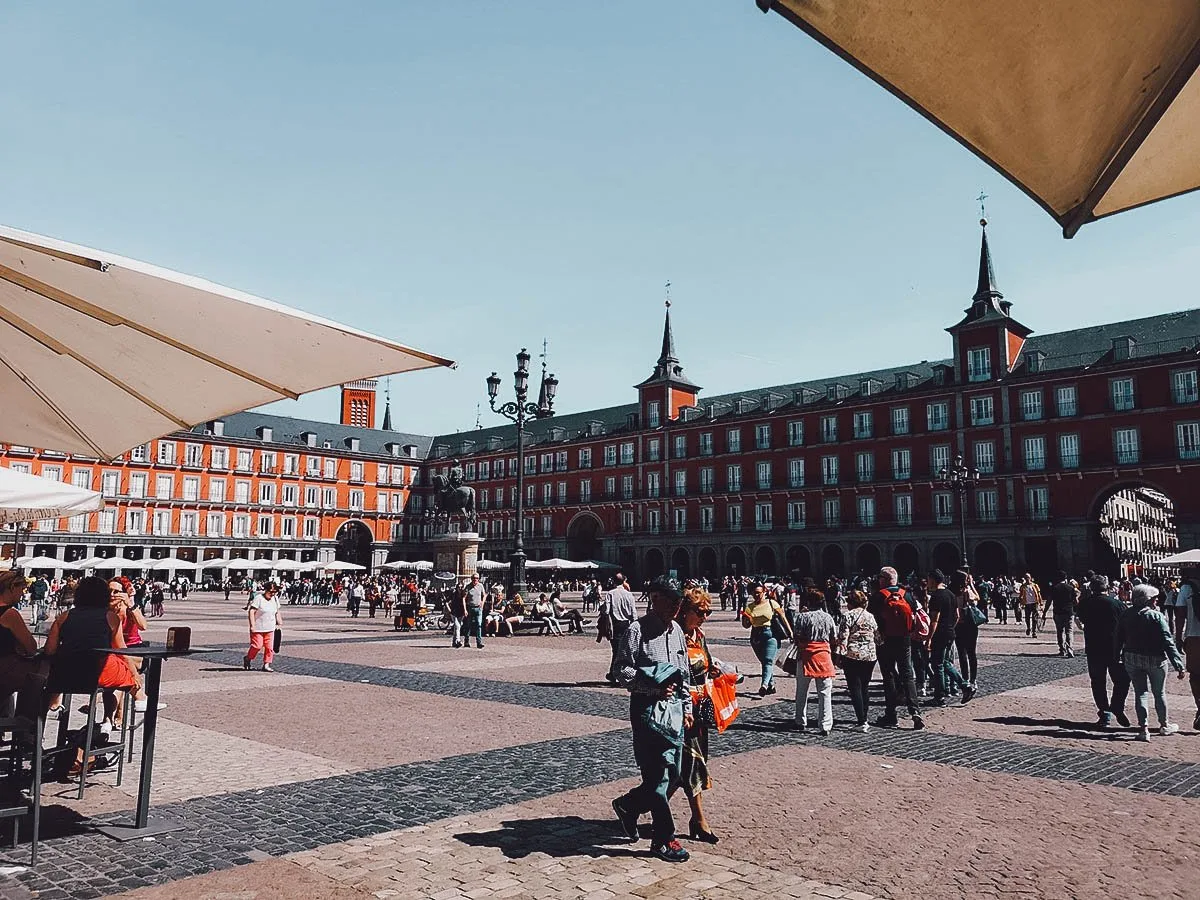
Nearest Metro Stations: Ópera (L2, L5, R), Sol (L1, L2, L3), Tirso de Molina (L1)
2. Explore Mercado de San Miguel
Mercado de San Miguel or San Miguel Market is by far the most famous market in Madrid. Similar to La Boqueria in Barcelona, it’s a Madrid institution and a must-visit for anyone looking to dive into Spanish cuisine.
Built in 1916, San Miguel Market opened as a local food market before growing into Madrid’s first gourmet market. It consists of over twenty stands whose offerings range from the finest Iberian ham to exquisite cheeses from Asturias to the freshest shellfish and seafood from Galicia.
Mercado de San Miguel is considered a culinary temple in Madrid and extremely popular. It receives over ten million visitors a year so expect a crowd at any time of the day. For the best experience, I suggest going as soon as they open at 10AM.
You can easily visit San Miguel Market on your own, but if you’d like to go as part of a guided sightseeing or food tour, then you can book one in advance through Get Your Guide.
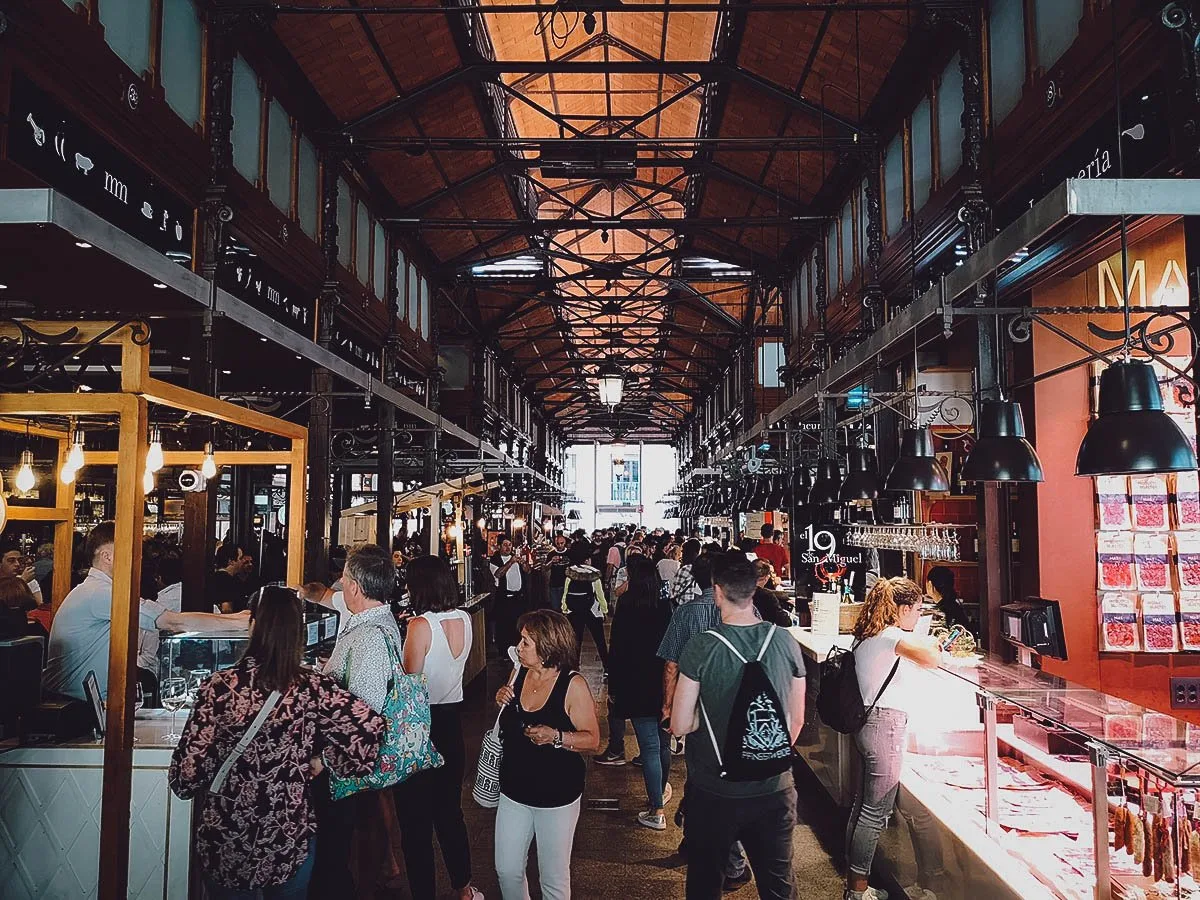
Operating Hours: 10AM-12MN, Sun-Thurs / 10AM-1AM, Fri-Sat
Nearest Metro Stations: Ópera (L2, L5, R), Sol (L1, L2, L3)
3. Take a Selfie with El Oso y El Madroño at Puerta del Sol
A short walk from Plaza Mayor is another iconic square in Madrid – Puerta del Sol. Like Plaza Mayor, it’s one of the busiest and most famous squares in Madrid. Known for its semi-circular shape, it’s regarded as “Kilometer 0” and is the center for all radial roads in Spain.
Aside from the stone slab marking Spain’s Kilometer 0, Puerta del Sol is famous for the clock on the Casa de Correos building and the statue known as El Oso y el Madroño. Meaning “The Bear and the Strawberry Tree” in Spanish, this sculpture is regarded as the heraldic symbol of Madrid.
It’s easy to visit Puerta del Sol on your own but if you’d like to go as part of a guided tour, then you can book one through Get Your Guide.
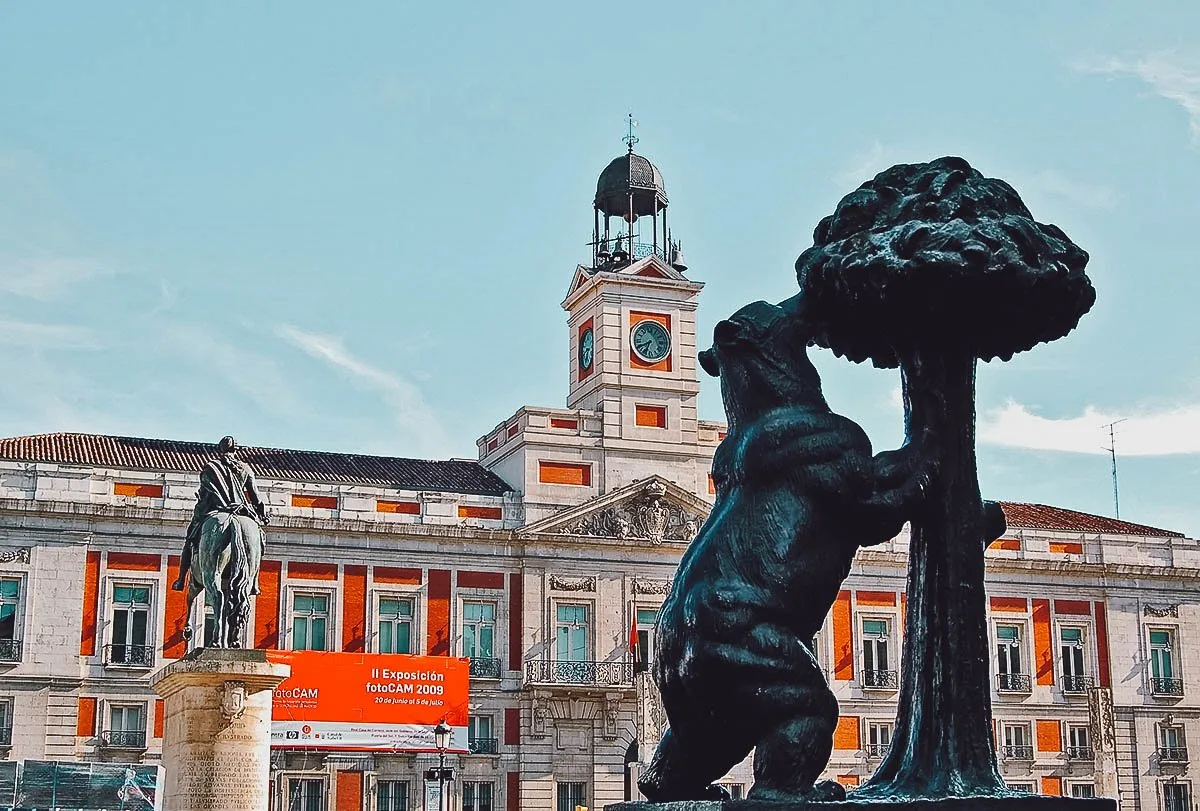
Photo by Juan Francisco Gallego Amador via Shutterstock
Nearest Metro Station: Sol (L1, L2, L3)
4. Go Shopping at the Golden Mile and Gran Vía
If you’re a fashionista looking to do some shopping in Madrid, then you’ll probably want to stroll the length of the Golden Mile and Gran Vía, two of the best shopping districts in the city.
Gran Vía is the busiest and most popular street in Madrid. It features 1.3 km (0.8 mi) of some of the most sought-after retail shops in town like H&M, Zara, PRIMARK, Lacoste, and the Atletico Madrid official store.
If over a kilometer of shops isn’t enough for you, then you can continue east to the Golden Mile, a cluster of stylish boutiques and exclusive brands located in the upscale neighborhood of Barrio de Salamanca. Think Chanel, Gucci, Louis Vuitton, and Tiffany & Co.
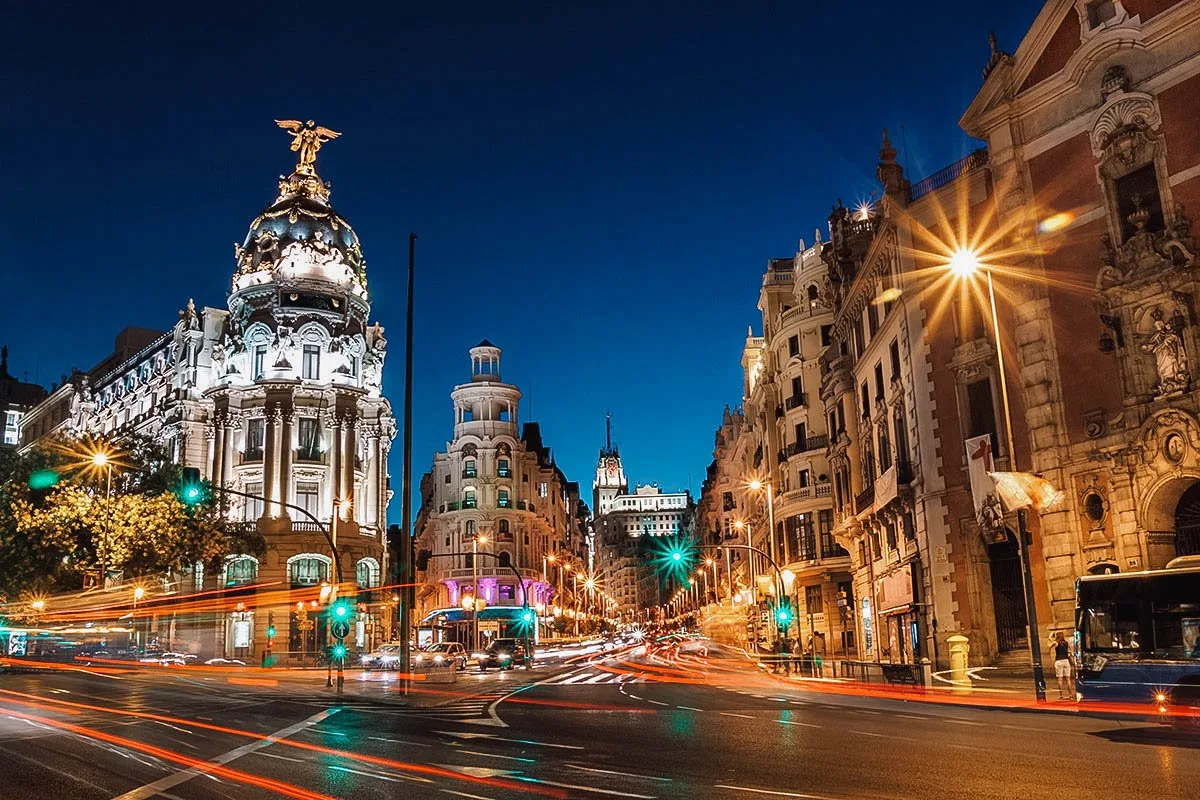
Photo by kasto via Depositphotos
Nearest Metro Station: Banco de España (L2), Callao (L3, L5), Gran Vía (L1, L5), Plaza de España (L2, L3, L10), Santo Domingo (L2)
5. Take a Stroll in El Retiro Park
Parque del Buen Retiro (or simply Retiro Park or El Retiro) is one of the largest public parks in Madrid. Together with Paseo del Prado, it’s a UNESCO World Heritage Site covering an area of about 125 hectares (309 acres).
Located not too far from the Prado Museum, Retiro Park is a green oasis with over 15,000 trees, a lake, gardens, monuments, and sculptures. It’s a great place to relax, take a stroll, or just escape the hustle and bustle of Madrid. Some of the most prominent features of El Retiro include the monument to King Alfonso XII, the Rosaleda (rose garden), the Palacio de Cristal (Crystal Palace), and the Paseo de las Estatuas (Statue Walk).
You can easily visit El Retiro Park on your own, but if you’d like to go as part of a guided tour, then you can book one through Get Your Guide.
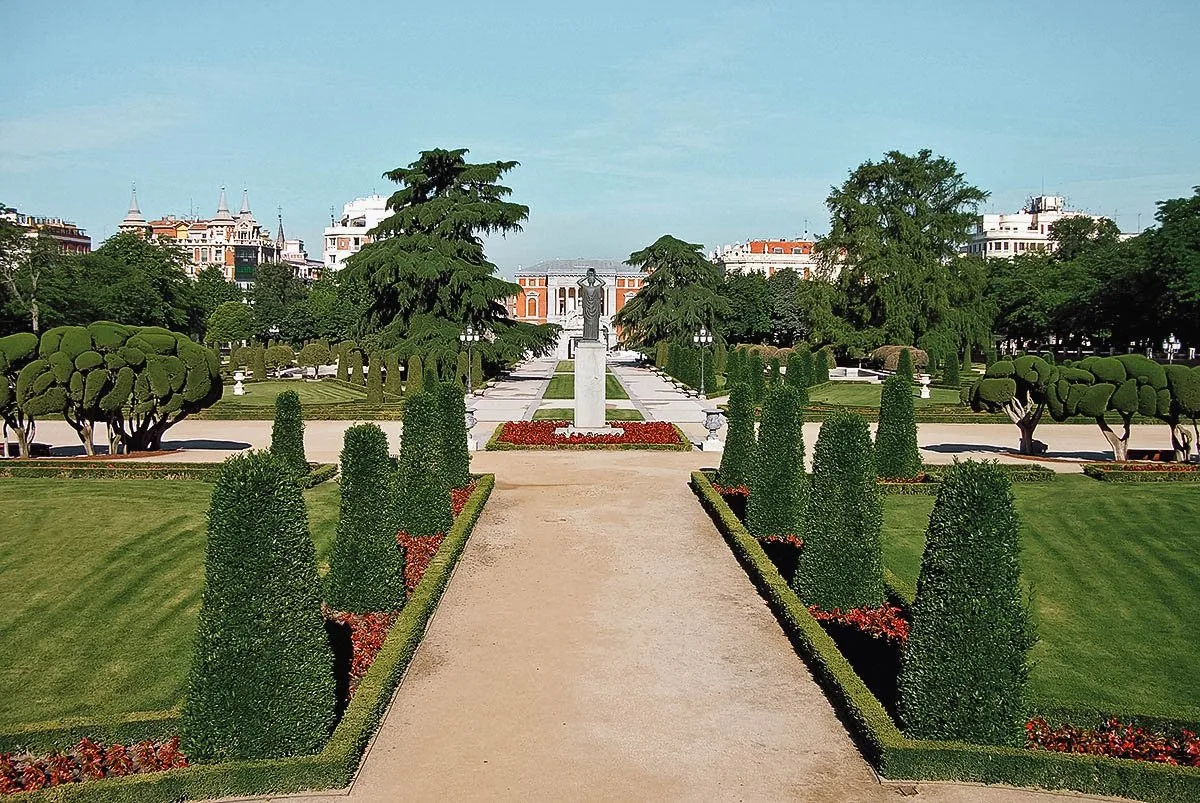
Photo by karnizz via Depositphotos
Nearest Metro Station: Estación del Arte (formerly Atocha) (L1), Ibiza (L9), Retiro (L2)
6. Watch a Flamenco Show
This picture of flamenco dancers performing in a cave was from a breathtaking show we saw in southern Spain. If you aren’t familiar with it, flamenco is a Spanish art form consisting of song, dance, and guitar playing. It’s a passionate and powerful art form which in my opinion, is an absolute must-do in Spain, especially if you can experience it in a cave.
Flamenco is originally from the Andalusian region so Granada is one of the best places to catch a show in Spain. But if Granada isn’t on your itinerary, then you can watch it in Madrid. Check out Get Your Guide for a list of flamenco shows held in the Spanish capital.
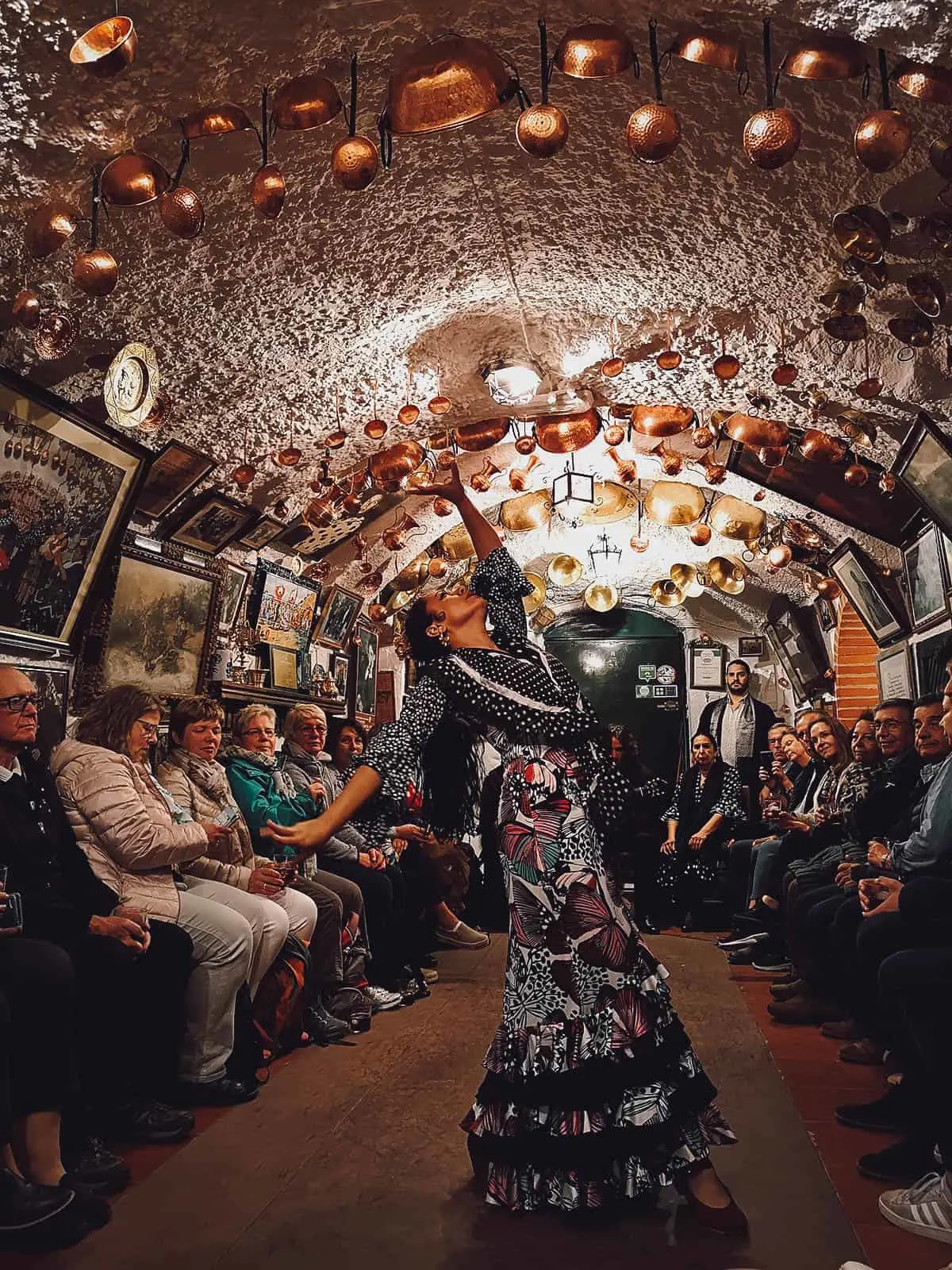
7. Visit a Weekend Market
On our last visit to Madrid, we stayed at an AirBnB directly across Matadero Madrid, a former slaughterhouse repurposed into a cultural center. It features multiple spaces dedicated to exhibits, performances, and workshops.
On the last weekend of every month, Matadero Madrid hosts the Mercado de Productores (pictured below), a farmer’s market with over fifty food stalls offering a variety of fresh produce and local dishes, all of which were produced in the areas immediately surrounding Madrid. If you’re lucky enough to be in Madrid at the end of the month, then I highly recommend checking out this market.
Another great weekend market to visit is El Rastro flea market, the biggest of its kind in Madrid. It’s held every Sunday and on public holidays and features over a thousand merchants selling a wide range of goods from artisanal products to accessories to clothing and kitchenware.

8. Go on a Madrid Food Tour
Exploring the local food in Madrid on your own is always fun but if you really want to learn about Spanish cuisine, then you may want to go on a guided tour. Simply put, no one knows the food in Madrid better than a local. A knowledgeable guide can take you from mercado to mercado and tapas bar to tapas bar to experience the best of local Spanish cuisine. Plus, they can give you lots of insider tips as well.
Check out Get Your Guide for a list of the best Spanish food and wine tasting tours in Madrid.
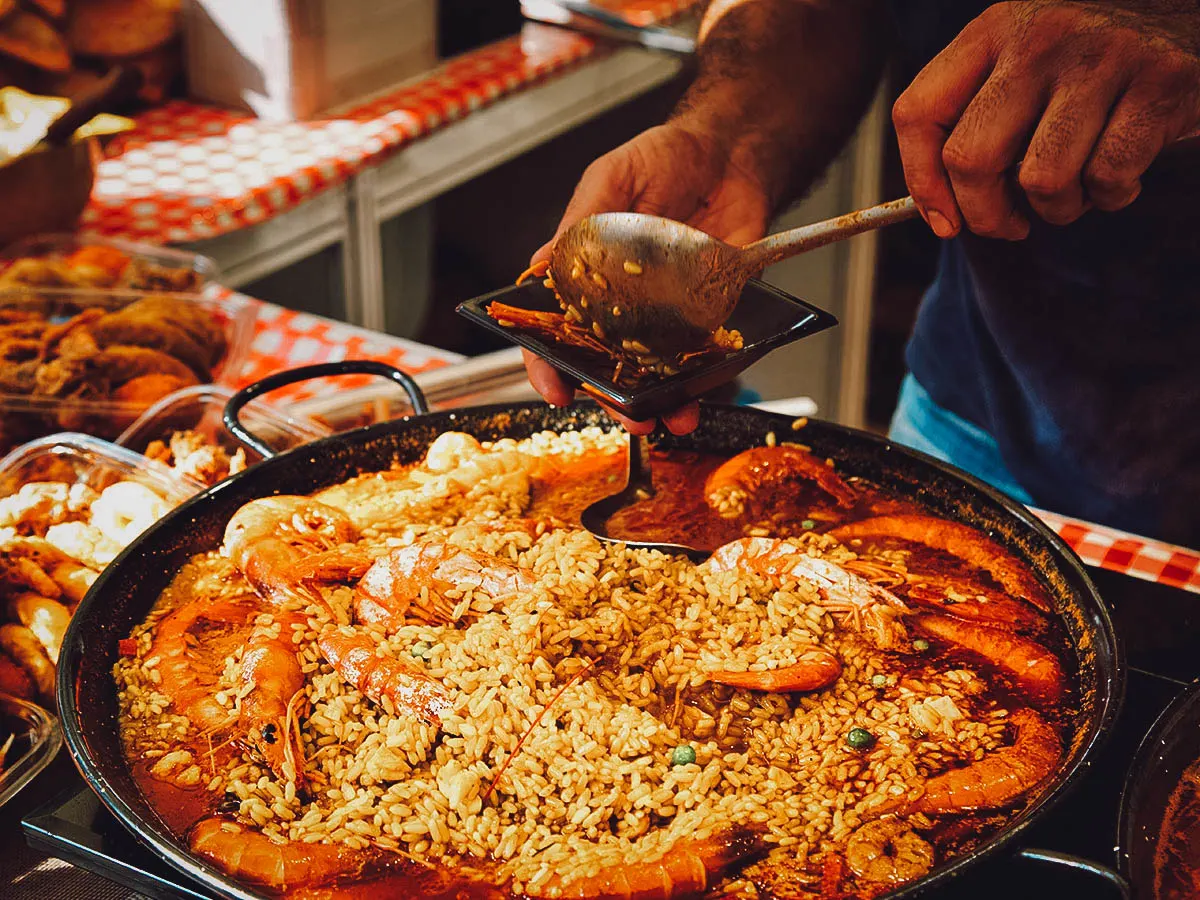
Photo by eskystudio via Shutterstock
9. Go on a Sightseeing Tour
Madrid has a terrific public transportation system making it very easy to get around. You can easily visit Madrid’s top tourist attractions on our own, but if you’re pressed for time, then you may want to book a guided sightseeing tour. Not only will you learn more about every place you visit, but it’s one of the easiest and fastest ways to see Madrid’s top sights.
Check out Get Your Guide for a list of guided tours in Madrid. Aside from the usual walking tours, they offer more fun tours as well like Segway tours and E-bike tours.
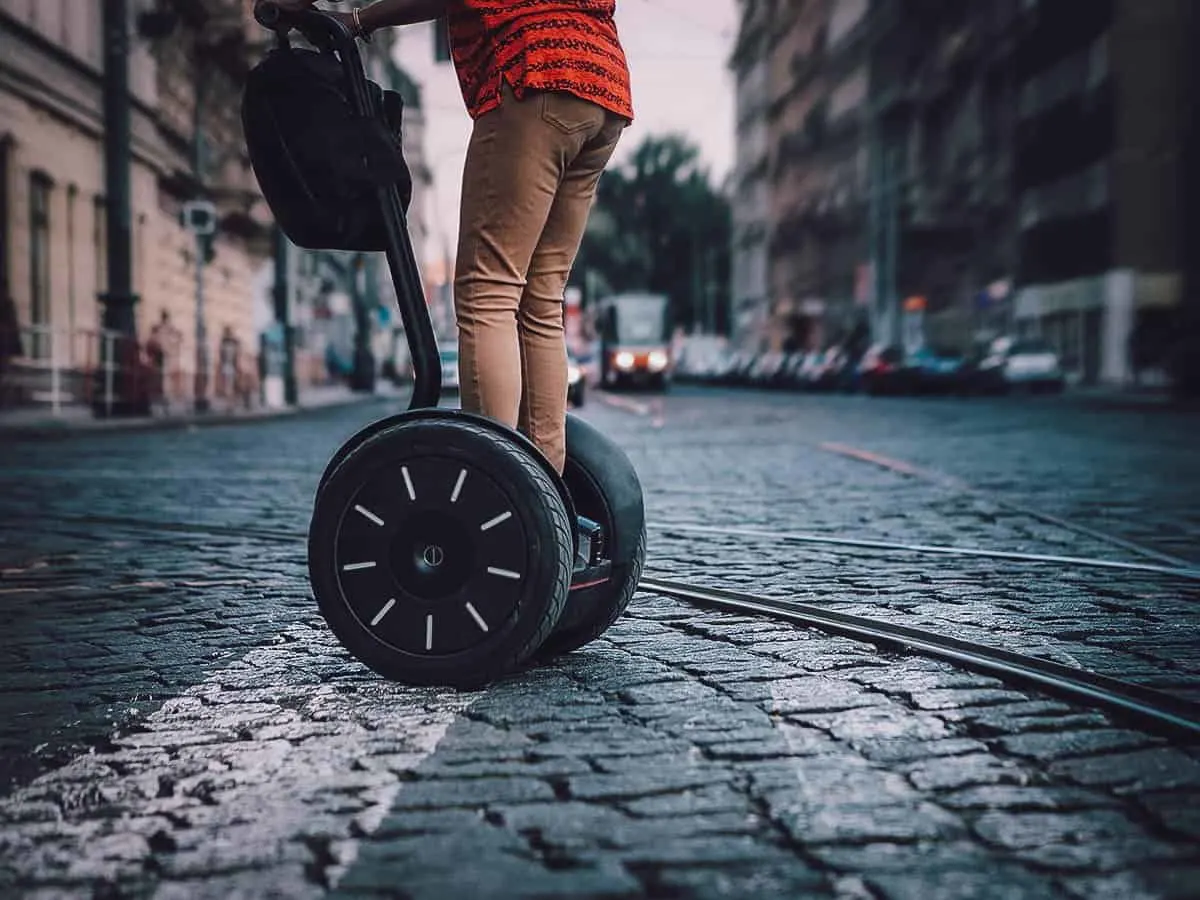
Photo by Soloviova Liudmyla via Shutterstock
10. Take a Cooking Class
Aside from food tours, we also enjoy taking cooking classes when we travel. It’s one of the best ways to learn about the local cuisine. Food tours can show you what and where to eat in Madrid but if you really want to learn about Spanish cuisine, then you may want to take a cooking class. Learning what goes into a dish is like looking under the cuisine’s hood.
If you’d like to learn how to make classic Spanish dishes like callos a la madfrileña or tortilla de patata (Spanish omelet), then check out Cookly for a list of cooking classes in Madrid.
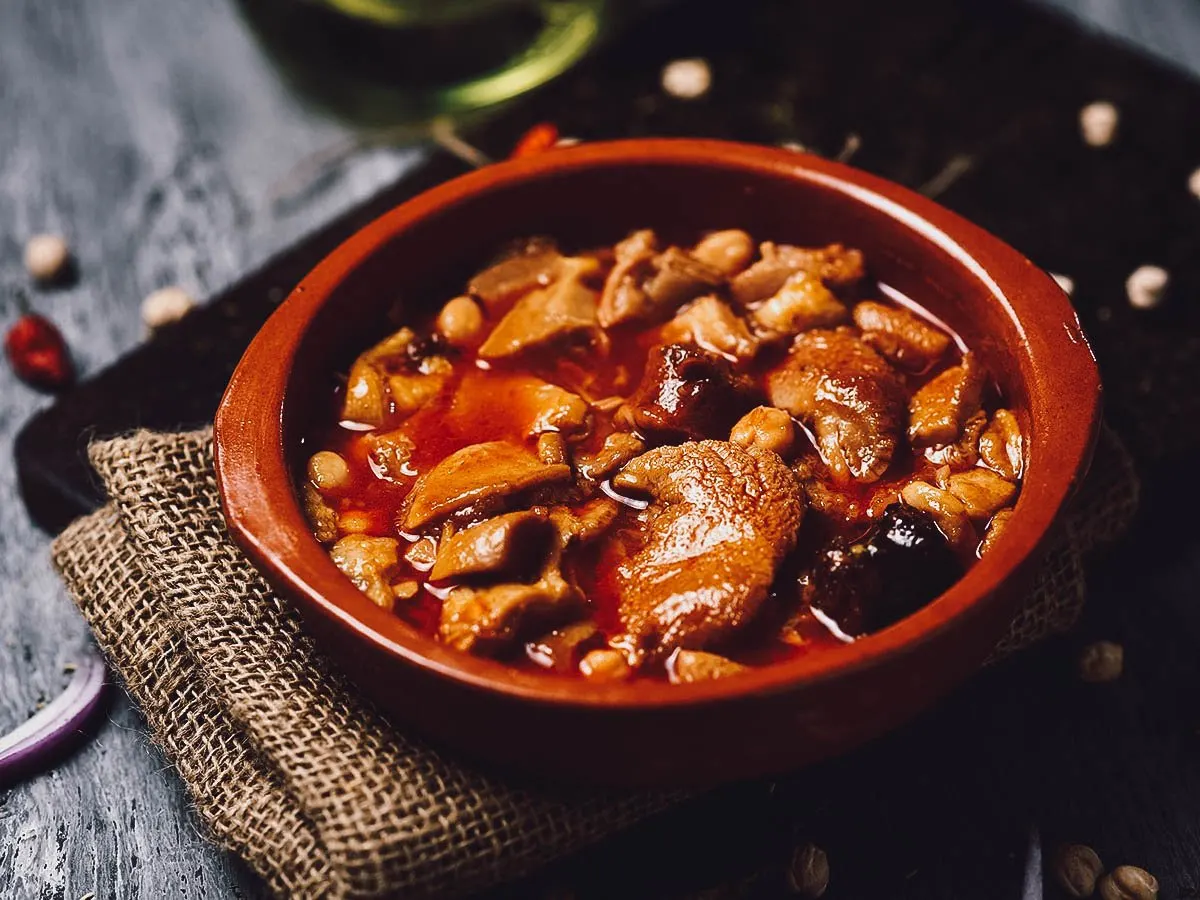
Photo by nito via Shutterstock
DAY TRIPS FROM MADRID
If you’re staying long enough in Madrid, then you might want to go beyond the city and take a day trip. I’ve listed three of the closest day trip destinations from Madrid below but be sure to check out our full article on Madrid day trips for more recommendations.
1. Toledo
Toledo is perhaps the most popular day trip destination from Madrid. Once referred to as the “City of the Three Cultures”, this UNESCO World Heritage Site can be reached in a little over half an hour by high-speed train.
Aside from its fascinating history and interesting architecture, Toledo is known for being the adopted home of El Greco, the famous Greek painter, sculptor, and architect of the Spanish Renaissance.
It’s easy to visit Toledo on your own but if you’d like to go on a guided tour from Madrid, then you can book one through Get Your Guide (Option 1 | Option 2).
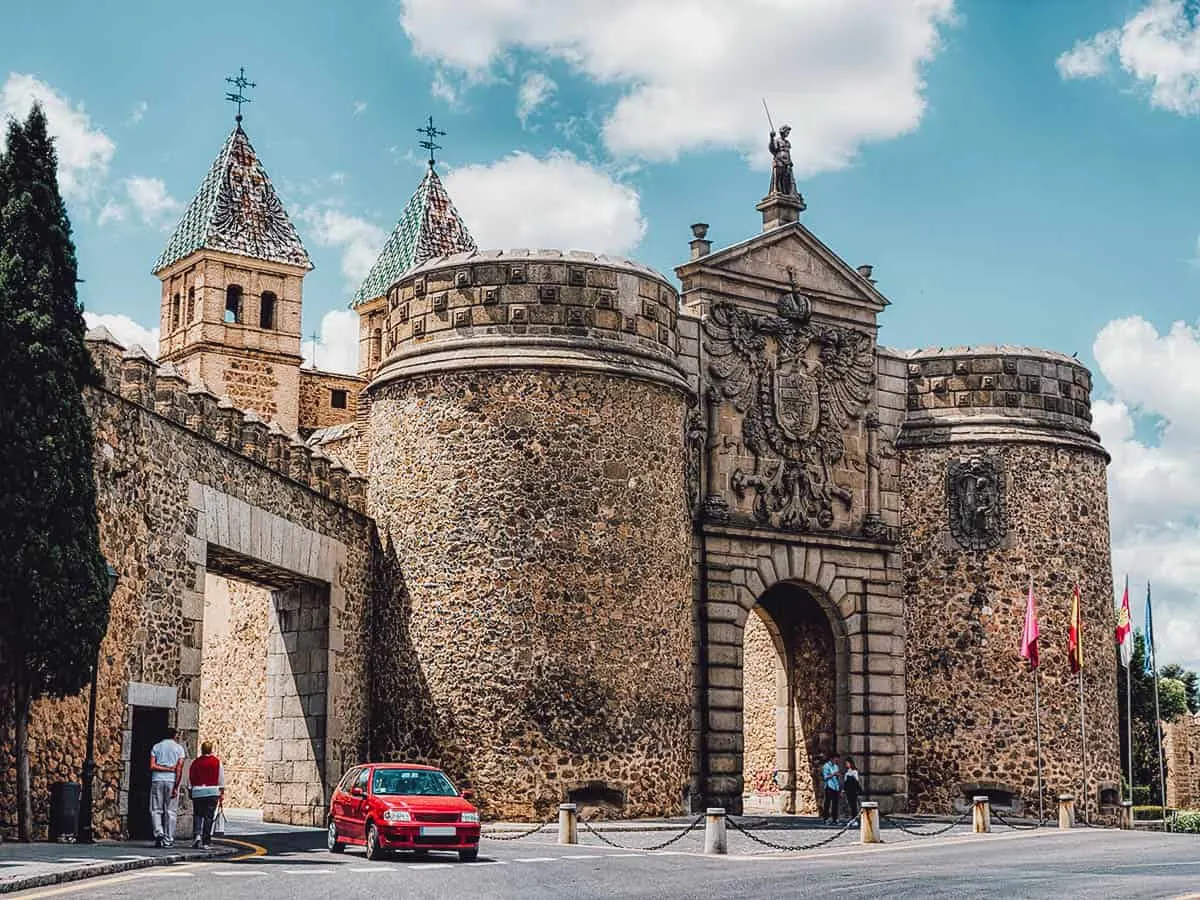
Photo by ArTono via Shutterstock
Travel Time: About 45 mins
2. Segovia
Another popular day trip destination from Madrid is Segovia. It’s located about 90 km (56 miles) northwest of Madrid and can be reached in a little over half an hour by high-speed train.
There are three architectural marvels to visit on a day trip to Segovia – the ancient Roman aqueduct (pictured below), the Alcazar, and the Catedral de Segovia. If you travel for food like we do, then you’ll be pleased to learn that Segovia is also famous for its cochinillo asado or roast suckling pig.
Like Toledo, Segovia is easy to visit on your own but if you’d prefer to go on a guided tour from Madrid, then you can book one through Get Your Guide (Option 1 | Option 2).
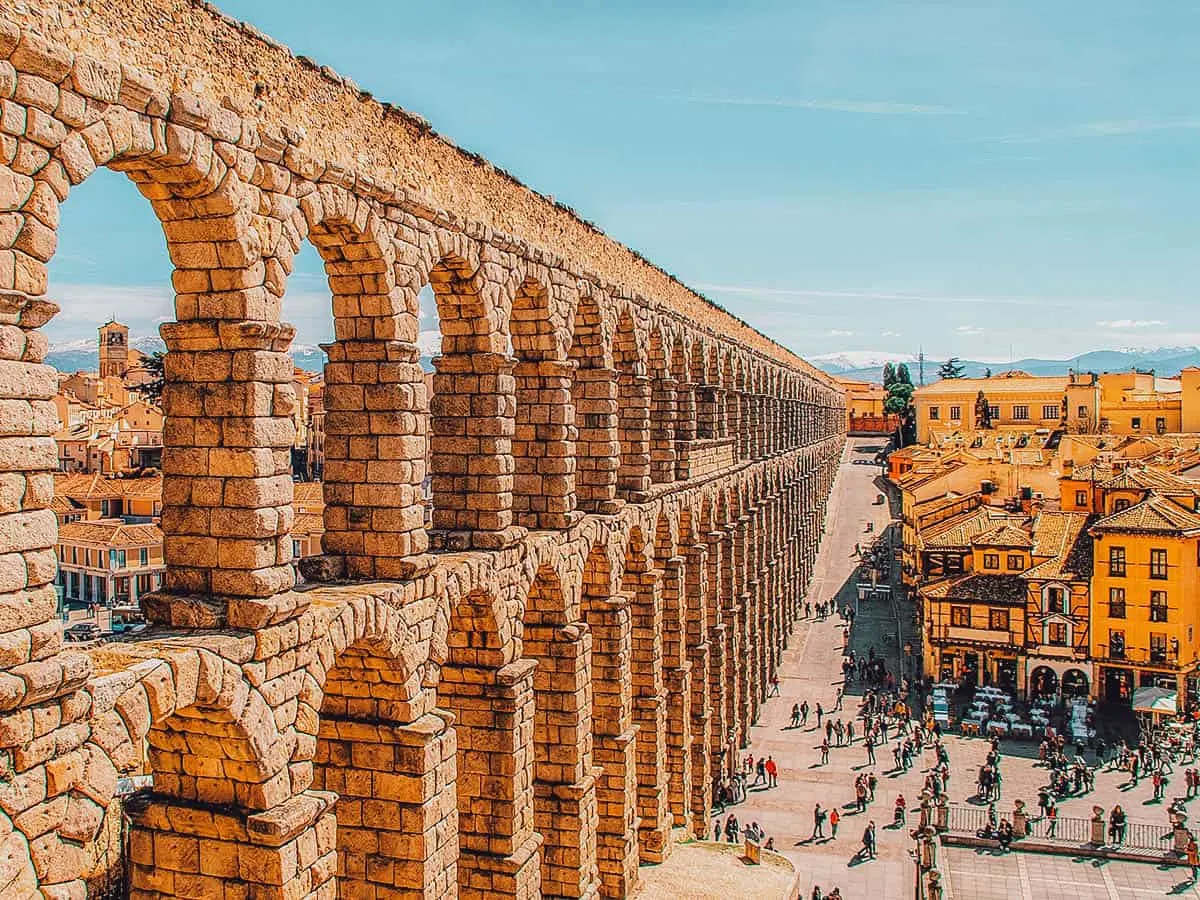
Photo by Vladimir Sazonov via Shutterstock
Travel Time: About 45 mins
3. San Lorenzo de El Escorial
Commonly known as the Monastery of El Escorial, San Lorenzo de El Escorial is the historic residence of the King of Spain. It’s a UNESCO World Heritage Site and one of the most important architectural monuments of the Spanish Renaissance.
San Lorenzo de El Escorial is located about an hour northwest of Madrid. You can buy entrance tickets at the gate or in advance through Get Your Guide. You can also go on a guided tour.
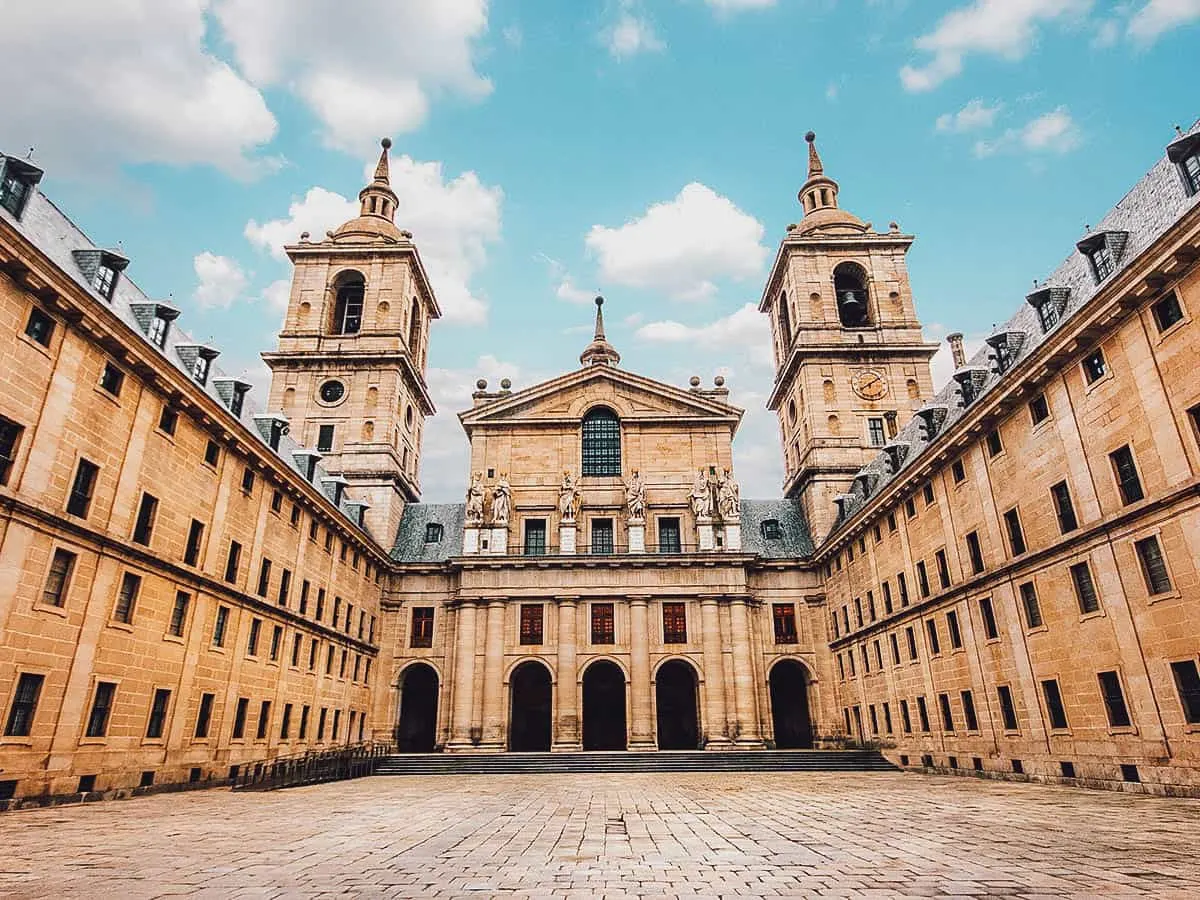
Photo by canadastock via Shutterstock
Travel Time: About 1 hr
SPANISH FOOD GUIDE
In our humble opinion, Spain is one of the world’s best countries for food. It’s home to many delicious dishes like paella valenciana, cochinillo asado, callos a la madrileña, tortilla de patatas, and churros con chocolate.
If you’re wondering what to eat in Madrid, then check out our Spanish food guide for a list of 45 of the most delicious dishes in Spain. If you’re obsessed with tapas like we are, then you need to check out our Spanish tapas guide as well.

SPANISH DESSERTS
Spanish dishes like paella and tapas are delicious but so are Spanish desserts. You’ve probably heard of churros con chocolate and flan but be sure to check out our article on Spanish desserts for more sweet recommendations in Spain.

WHERE TO EAT IN MADRID
Our Spanish food guide shows you the best dishes to eat in Madrid and Spain, but if you’re wondering where you should go for lunch or dinner in the Spanish capital, then be sure to check out our Madrid food guide. It lists fourteen of the best restaurants, tapas bars, mercados, and tabernas to visit in Madrid.
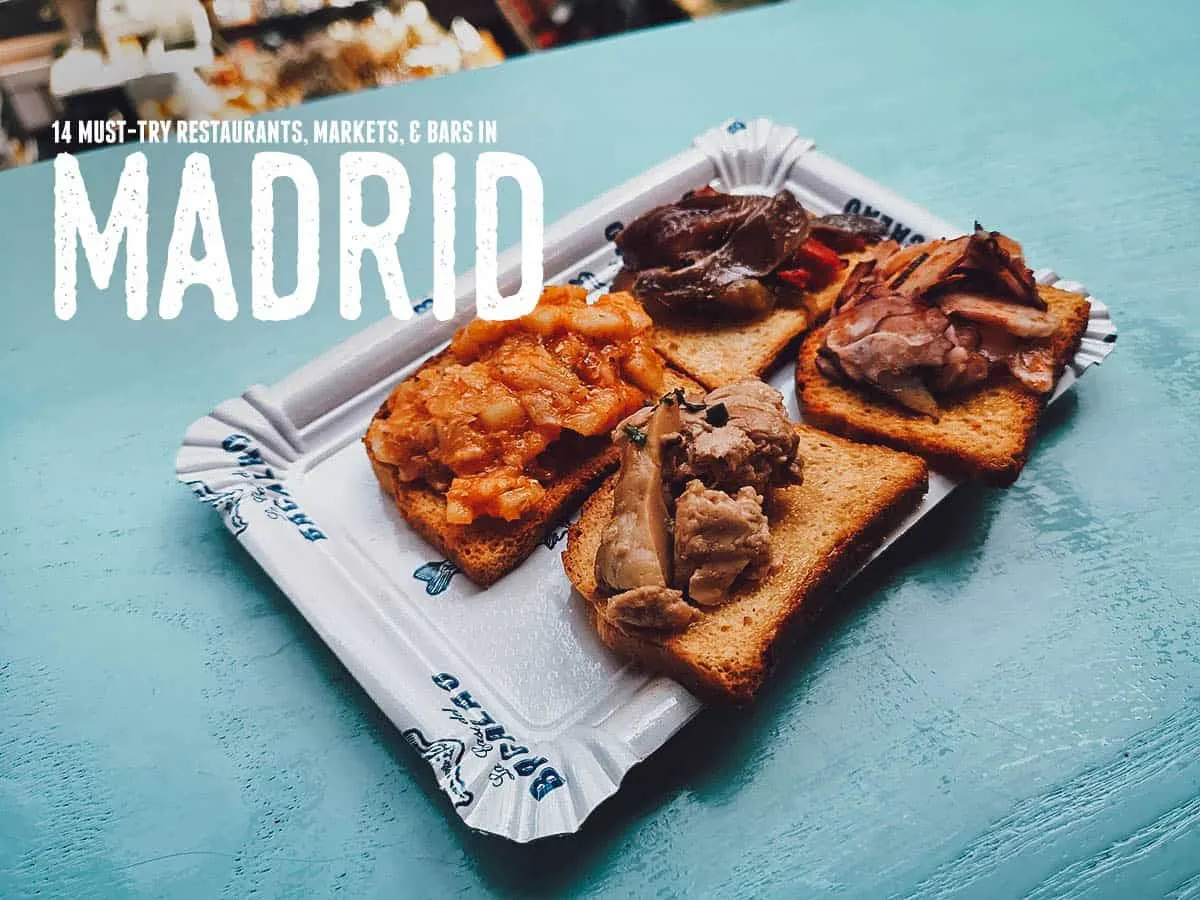
Fourteen may be too many for some people so I’ve listed five of our favorites below. Be sure to click through to the complete food guide for more pictures and information.
1. La Venencia
La Venencia is an icon in Madrid. It’s an historic bar and local hangout that hasn’t changed since the days of the Spanish Civil War. They offer a small menu of tapas and just one drink – Sherry wine. Also known as Vino de Jerez, it’s a type of Spanish fortified wine produced in the Jerez-Xeres-Sherry region of Andalusia.
If you enjoy a bit of history and local flavor with your food, then I suggest enjoying a few drinks and tapas at La Venencia. Rumor has it that Ernest Hemingway was a regular here.
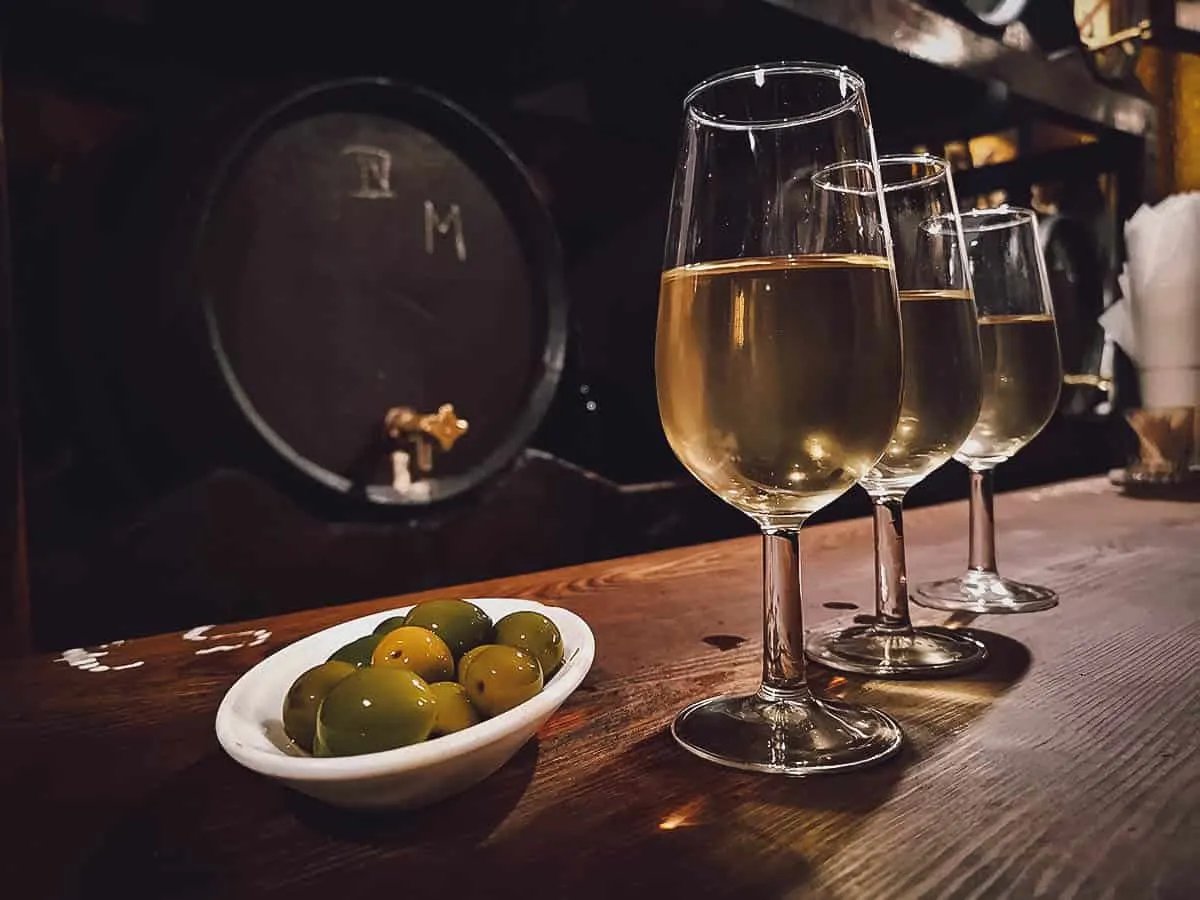
2. Bodega de la Ardosa
Bodega de la Ardosa was one of our favorite tapas bars in Madrid. It’s a Madrid institution and a neighborhood favorite that’s been around since 1892.
Unlike La Venencia which is more of a specialized bar, Bodega de la Ardosa has a full bar and offer many tapas dishes like salmorejo, tortilla de patata, and this terrific plate of alcachofas or grilled artichokes sprinkled with salt.
Bodela de la Ardosa is extremely popular with the locals so it’s best to go on a weekday. I tried going on a Sunday and the place was practically bursting at the seams. On a Monday afternoon, we had the place to ourselves.

3. La Tasqueria de Javi Estevez
La Tasqueria de Javi Estevez is one of the most interesting restaurants we went to in Spain. It’s an upscale restaurant known for offering an entire menu of offal-inspired dishes like lamb sweetbreads, beef tongue, and pork cheek.
If that isn’t enticing enough for you, then you may be pleased to learn that La Tasqueria de Javi Estevez is the proud owner of one Michelin Star, making it perhaps the only Michelin-starred offal restaurant in the world!
If you like experiencing unusual food when you travel, then you need to make a reservation here. Check out my article on La Tasqueria for more information.

4. Chocolateria San Gines
Google “things to do in madrid” and this famous chocolateria will surely come up. Chocolateria San Gines is one of the most iconic places to eat in Madrid. They’ve been open since 1894 and is the most famous place in the city to have churros con chocolate (churros with hot chocolate). It’s a delicious pairing that’s often enjoyed for breakfast or as a snack in Spain.
No matter how long you’re staying in Madrid, you need to have a plate of churros with hot chocolate at Chocolateria San Gines. It’s a Madrid institution and almost a rite of passage for first-time visitors to Madrid.
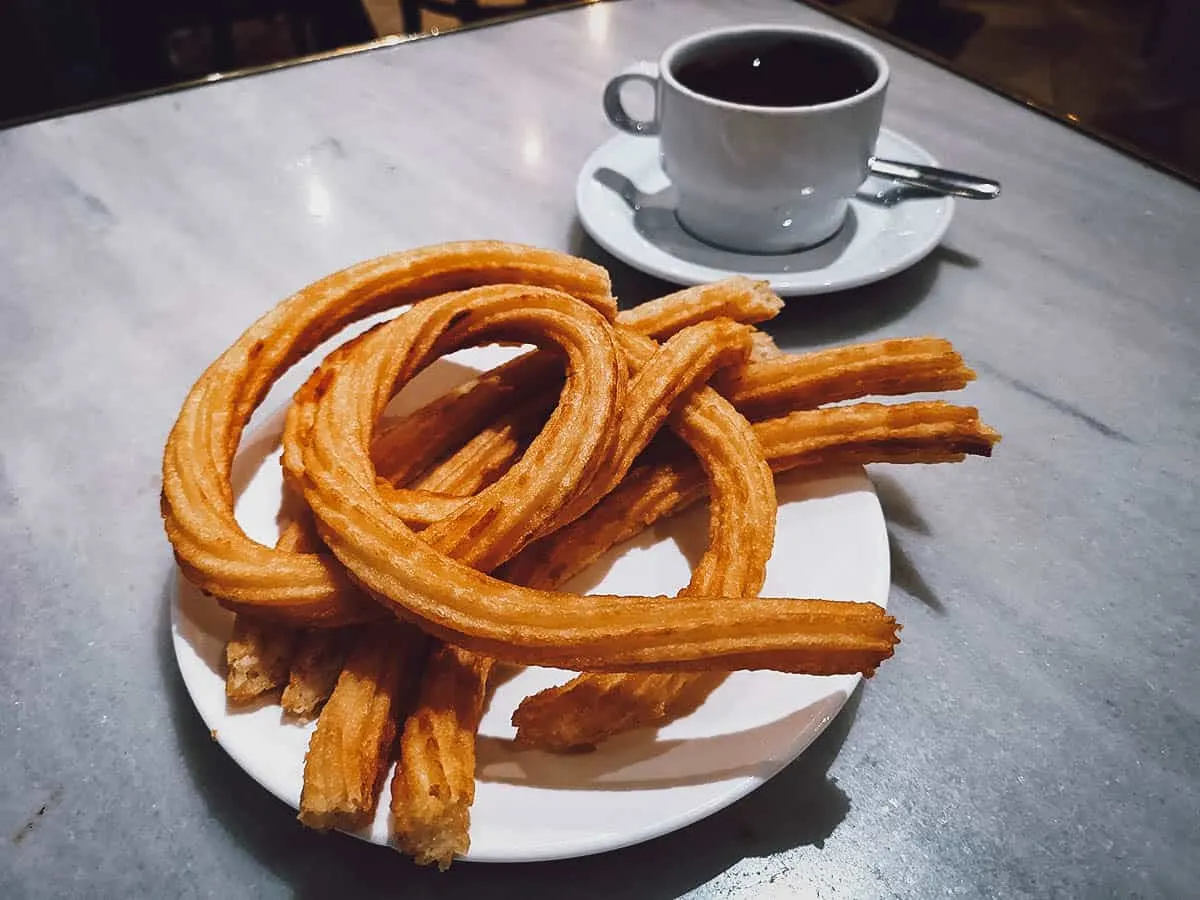
5. Mercado de San Fernando
Mercado de San Miguel (San Miguel Market) may be the most famous but it wasn’t our favorite market in Madrid. Like La Boqueria in Barcelona, it’s too popular and crowded and doesn’t offer the most relaxed dining experience.
We explored several mercados in Madrid and Mercado de San Fernando was the one we enjoyed the most. It’s located in the colorful Embajadores/Lavapies neighborhood and offers a diverse mix of stalls offering a range of international and Spanish cuisine.
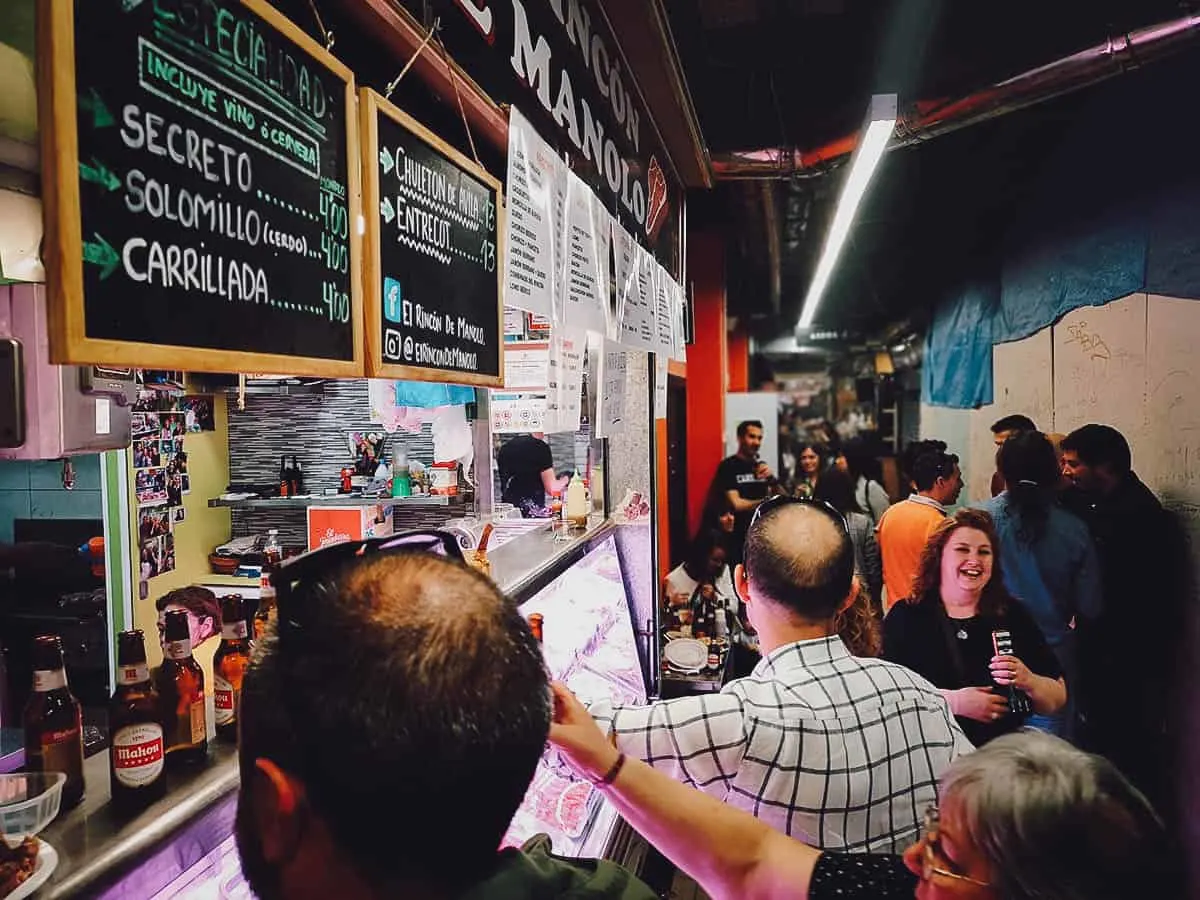
POINTS OF INTEREST IN MADRID
To help you navigate, I’ve pinned the places recommended in this Madrid travel guide on a map. Click on the link to open the live map in a new window.
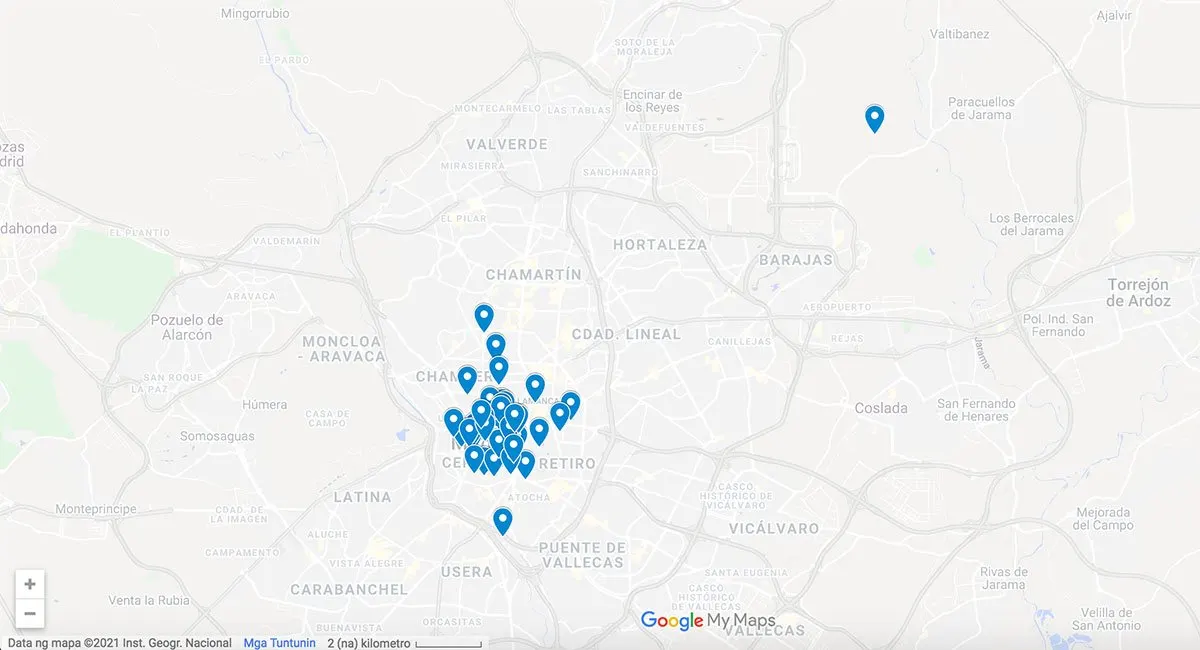
HOW TO GET AROUND IN MADRID
Madrid is a highly walkable city with great public transportation so it’s easy to explore on your own. Depending on your needs, I highly recommend getting either of these Madrid transport cards.
Tourist Travel Pass
If you plan on using public transportation a lot in Madrid, then it may be worth it to get a Tourist Travel Pass. It’ll give you unlimited rides on all forms of public transport for the duration of your pass.
Tourist Travel Passes in Madrid are valid for 1, 2, 3, 4, 5, or 7 days and come in two versions – Zone A and Zone T. If you’re planning on exploring just the city center, then a Zone A pass is enough. But if you intend to explore the surrounding areas of Madrid like San Lorenzo de El Escorial, then it’s best to get a Zone T pass.
Tourist Travel Passes are available for purchase at any metro station in Madrid, including the airport. Click on the link for more information on the Madrid Tourist Travel Pass.
10-Journey Tickets
If you plan on using public transportation but not often enough to warrant an unlimited pass, then you may want to get a 10-journey ticket instead. This is what we did. We got a 10-journey ticket for Zone A (central Madrid) which was more than adequate for our needs.
Like a Tourist Travel Pass, you can get a 10-journey ticket from any metro station. Click on the link for more information on the 10-journey ticket in Madrid.
Google Maps
No matter how you get around, I suggest downloading the Google Maps app (iOS | Android) if you haven’t already. It’ll tell you all the different ways to get from point A to point B by walking or using any city’s public transportation system. It’s accurate and reliable and something we can’t travel without.
HOW MANY DAYS TO STAY / MADRID ITINERARY
With so much to see and do in the Spanish capital, you’re probably wondering “how many days are enough for Madrid?” That’s a great question and the not so great answer is, it depends.
Staying longer is always a good idea anywhere but if you’re pressed for time, then three full days should be enough. It’ll give you enough time to see all the major sights in Madrid. But if you’re a serious art lover and want to fully explore the major museums in Madrid, then 4-5 days would be better.
Here’s a sample 3D/4N Madrid itinerary to help you plan your trip.
| DAY ONE • Prado Museum • Cibeles Palace • Take a stroll on Gran Vía • Explore Chueca • Explore Malasaña |
| DAY TWO • Thyssen-Bornemisza Museum • Puerta del Sol • Chocolateria San Gines • Plaza Mayor • Mercado de San Miguel • Royal Palace of Madrid |
| DAY THREE • Reina Sofía Museum • Retiro Park • Explore Lavapiés • Watch a flamenco show |
MADRID TRAVEL TIPS
1. Plan your Trip with Sygic Travel
If you enjoy every facet of travel planning like I do, then you’re going to find the Sygic Travel app useful. I’ve been using this free trip planning app to create our itineraries for several years now. You can download it for free on iOS or Android.
2. Save on Attraction Costs with a Go City Pass
Visiting Madrid’s myriad attractions is fun, but it can also be expensive. Entrance fees can add up which is why tourist discount cards like the Go City Pass can come in very handy.
We used the Go City Explorer Pass in Barcelona and saved over 21% on admission and tour costs. Check out the Go City website for more details.
3. Rent a Pocket Wifi Device
Having a stable wifi connection is a must when traveling. You’ll need it to navigate, do research, translate signs, and stay connected on social media. Having access to Google Maps alone justifies the cost.
We brought our own Pokefi devices so we didn’t need to rent any mobile routers in Europe. But if you do need a device that works in Madrid and Spain, then you can rent one through Get Your Guide.
4. Save Money With a Paseo del Arte Pass
If you plan on visiting the Prado museum, Thyssen-Bornemisza, and Reina Sofía in Madrid, then it’s a good idea to get the Paseo del Arte Pass. Aside from the convenience of not having to line up for tickets each time, you’ll save money on the total cost of admission.
5. Be Wary of Pickpockets
Pickpocketing and petty theft are common in Spain, especially in bigger cities like Madrid and Barcelona. You need to be aware of your surroundings and always be mindful of your belongings. Be especially vigilant in busy tourist areas like Plaza Mayor, Puerta del Sol, and El Retiro flea market.
6. Store Your Luggage
Homestay platforms like AirBnB and Vrbo are becoming more and more popular these days so having a place to store your luggage can be a concern. If you need a safe place to store your luggage for a few hours, then you can check Luggage Hero for available storage options in Madrid.
7. Check for Madrid Travel Deals
You can buy vouchers for tours and other travel-related services from many online platforms. For a trip to Madrid, I suggest checking Get Your Guide and Klook. They’re both trusted tour providers offering a good selection of deals on tours, transfers, tickets, and more.
8. Rent a Car
Renting a car is one of the best ways to experience and explore Spain. We rented a car and drove from San Sebastian to Santiago de Compostela and it turned out to be one of the most memorable legs of our trip.
If you’re considering renting a car in Spain or anywhere else in Europe, then you can do so through Rentalcars.com.
9. Get Travel Insurance
To be honest, we didn’t used to get travel insurance often, but we do now, on every trip. Frankly, you never know what can happen when you’re traveling. Valuables can get stolen and you can get hurt. Travel insurance is one of those things that you hope to never use, but if you do wind up needing it, then you’ll be glad you had it.
We always get travel insurance from SafetyWing or Heymondo. They’re both popular travel insurance providers used by many long-term travelers. Click on the links to get a free quote from SafetyWing or Heymondo. Get 5% off on Heymondo if you pick up a policy using our link.
10. Bring the Right Power Adapter
Spain has Type C or Type F electrical outlets so be sure to bring the right power adapters for your devices. Electrical voltage is 230V and the standard frequency is 50Hz.
Have Fun!
I’m by no means an expert on the Spanish capital but I do hope you find this Madrid travel guide useful. I’m only sharing some of the things I learned from our trip. If you have any comments or suggestions, then please feel free to leave them in the comment section below.
Thanks for reading and have a great time visiting the art museums and neighborhoods of Madrid!
Disclosure
Some of the links in this Madrid travel guide are affiliate links, meaning we’ll earn a small commission if we make a sale at no added cost to you. We only recommend products and services that we use ourselves and firmly believe in. We really appreciate your support as this helps us make more of these free travel guides. Thank you!


Nabil
Wednesday 8th of February 2023
I suggest for the visitors to Madrid not to exchange currency at the air port because the exchange there is a thief with white gloves. They sell Euro at $1.36 and the buy is $0.87 so they make about $0.50 for each full euro exchage and this is outrageous. Actually after my transaction was completed, I realized the exchange amount which he did not disclose so after I got almost to the gate I went back and returned the money and cancelled the transaction. So do not exchange at the airport given that you can use your credit card everywhere and enjoy your vacation and the Spanish food. Nabil - February 2023
Veronika
Tuesday 4th of October 2022
What a great article! We're currently dreaming of going to Madrid again - we've been there before and we love, love love it! Here's to a year with loads of travel plans and new experiences!
- Veronika
Abushi Kamal
Friday 30th of September 2022
I like it.
Metrocazar
Tuesday 26th of April 2022
Many thanks for this very Madrid travel guide. Madrid is a very nice city and I can confirm that the suggested day trips are all worth visiting. A nice aditional trip is "Castillo Viejo de Manzanares el Real" which is a bus ride of approx. 40mins. Perhaps is our online navigation system for the metro (subway) useful as well when visiting Madrid.
Jojo
Wednesday 3rd of November 2021
Favorite thing about Madrid was all the street art everywhere! And the food was delicious!
JB & Renée
Sunday 7th of November 2021
@Jojo: Indeed! Absolutely loved everything about Madrid.